The standout shows of Milan Fashion Week S/S 2026
This season in Milan, the city is enjoying a wave of creative director debuts, from Demna at Gucci to Louise Trotter at Bottega Veneta. Here are the Wallpaper* highlights so far
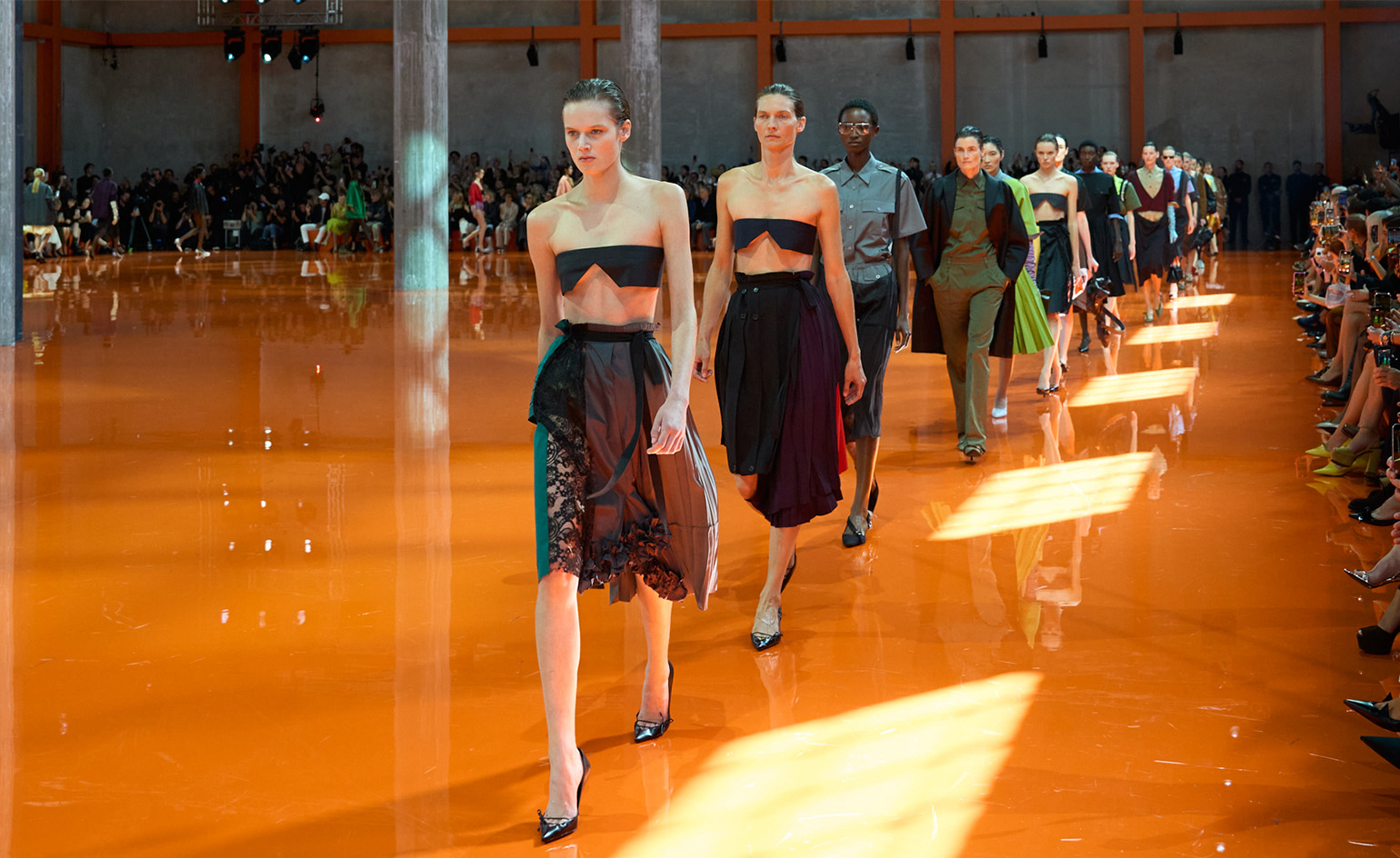
Orla Brennan
There’s a new guard in town at Milan Fashion Week this season, as several of the city’s houses unveil newly instated creative directors. On Tuesday (23 September), subversive Georgian designer Demna (formerly of Balenciaga) kicked off proceedings with a soft launch of his Gucci tenure, inviting a select group of guests to a Spike Jonze and Halina Reijn-directed short film titled The Tiger (more on which in our MFW live blog). Debuts, indeed, have continued to be highlights of the week thus far. Following suit, Simone Bellotti stepped into the spotlight at Jil Sander on Wednesday: taking over from husband-and-wife duo Luke and Lucie Meier after their ten-year tenure, he laid down a new chapter for the label at the brand’s Milanese headquarters. Next up was ex-Miu Miu designer Dario Vitale, who showed his opening vision for Versace at a special event within the opulent Pinacoteca Ambrosiana on Friday, presenting a collection that dug into Gianni Versace’s 1980s archive.
Last night, all eyes were on Bottega Veneta as Louise Trotter presented her first collection for the Italian house (notably, Trotter is one of the few female appointments in the big fashion-house shake-up of 2025). Elsewhere, the city’s heavyweights – Prada, Dolce & Gabbana, Missoni, Ferragamo and Fendi – have delivered their typically high-production shows, while younger names have brought a buzz of new energy to the city, including London’s own KNWLS, which joins the Milan calendar for the first time. As well as new beginnings, there comes one poignant farewell – a runway show this evening in memory of the late Giorgio Armani, who passed away earlier this month at the age of 91. The presentation will honour an irreplaceable visionary who has shaped decades of Italian style and culture.
Here, reporting from Milan, Wallpaper* fashion features editor Jack Moss and contributing fashion writer Orla Brennan pick MFW’s standout shows – as they happen.
Bottega Veneta
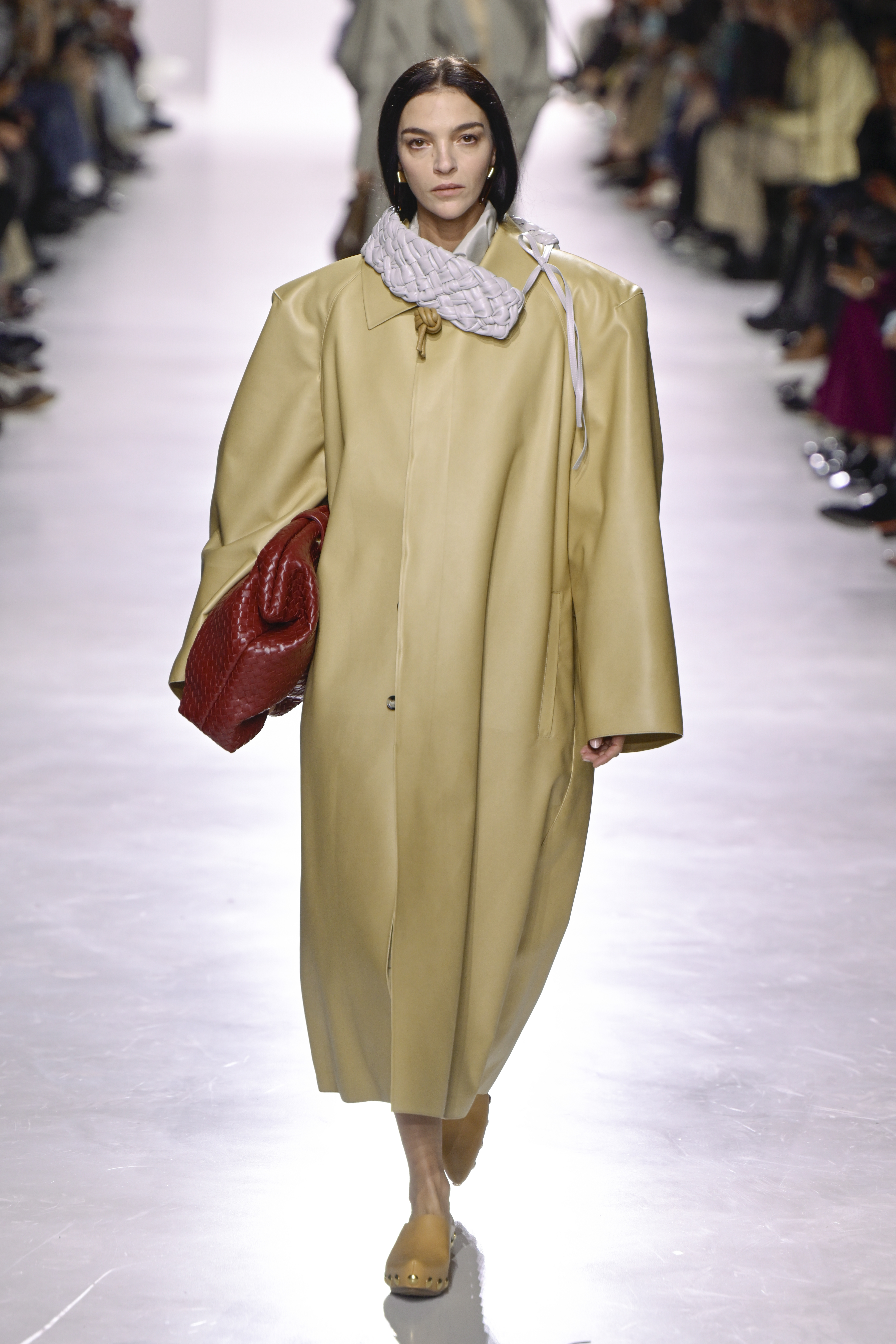
For her debut collection for Bottega Veneta – perhaps Milan Fashion Week’s most anticipated runway show – British designer Louise Trotter looked towards the figure of Louise Braggion, the house’s first female creative lead, who worked from the 1980s to early 2000s. The choice was pertinent: Trotter’s appointment was praised for making her a rare woman creative director at a major fashion house; here, she paid homage to a little-known female designer who never got her dues. Braggion, Trotter elaborated backstage after the show, was Italian, but moved to New York in the early 1980s to be a part of Andy Warhol’s Factory. ‘I was imagining her journey – her freedom of being an Italian woman, an archetypal Italian woman, moving to New York. And what that experience meant,’ she said. ‘It was a liberation for her. And that's really what I wanted to capture – a feeling of liberation.’
In the collection, this journey was imagined in what the collection notes described as capturing ‘the extravagance of Venice; the energy of New York; the essentialism of Milan’. Indeed, garments shifted between a feeling of rigour – broad-shouldered overcoats, high-neck shirts, plays on the tuxedo jacket – and flourishes of colour and texture, like a series of dresses and skirts constructed from a boldly-hued fabric comprising thousands of iridescent strands. Elsewhere, intrecciato – the brand’s signature leather-weaving technique – was used as a motif throughout, including across elongated epaulettes and collars. Trotter said that intrecciato was a metaphor for Bottega Veneta’s extraordinary craft abilities (she says working there as a designer is like being in a ‘candy box’), describing it as the ‘language’ of the house, a symbol of ‘collaboration and connectivity’. This was reflected in the soundtrack, an ‘audio artwork’ by Steve McQueen, which saw the voices of David Bowie and Nina Simone – each singing their version of Wild is the Wind – interwoven to arresting effect. Jack Moss
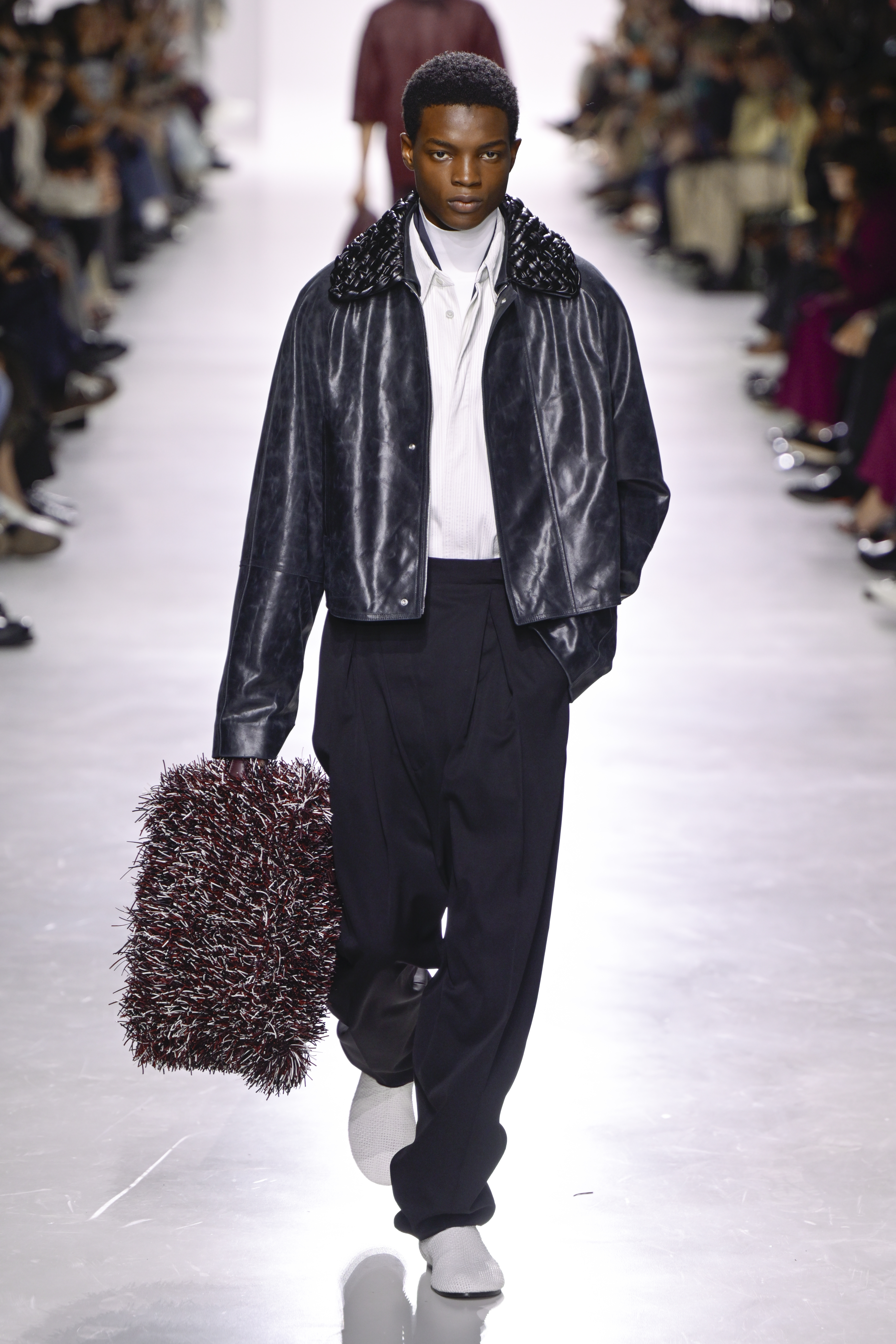
Dolce & Gabbana
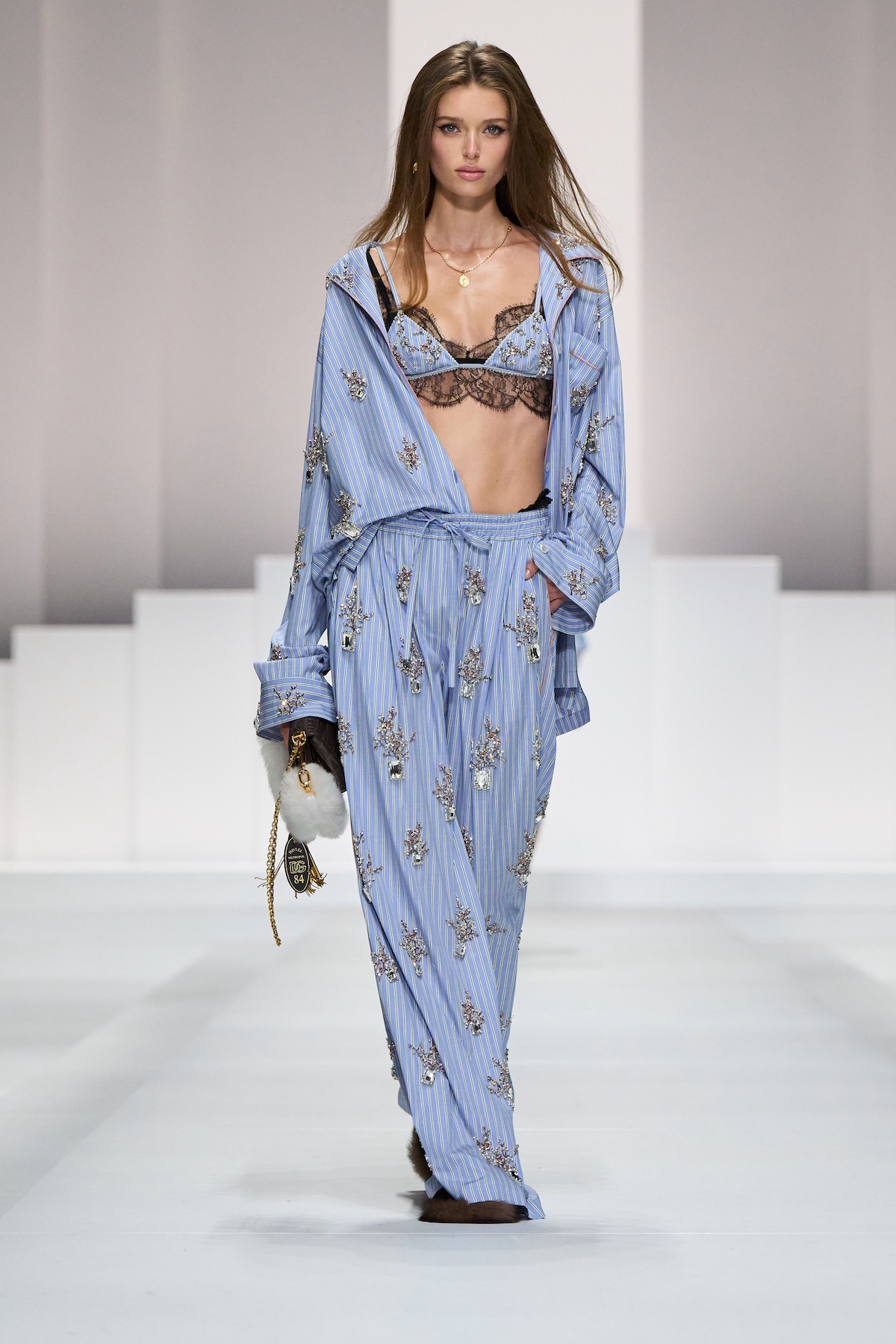
The star guests of Dolce & Gabbana’s Saturday afternoon pyjama party were the cast of Devil Wears Prada, the sequel of which is currently filming in Milan. Miranda Priestly (Meryl Streep), Nigel Kipling (Stanley Tucci) and Simone Ashley (an as-yet-unknown addition to the Runway team) arrived to the show at the Metropol theatre fashionably late, their appearance drawing an ovation from the gathered crowd (even Anna Wintour, the purported inspiration behind Streep’s fearsome Priestly smiled and waved across the runway; both wore their sunglasses throughout). As for whether the scene is being shot for the film or simply some clever marketing, the fictional team watched on from the front row as Stefano Gabbana and Domenico Dolce presented a breezy summer offering that built on their menswear collection,‘Pyjama Boys’, shown earlier this summer. Bedwear continued to be the thematic thread here, moving from striped pyjama sets smattered with gobstopper jewels and crystals towards more sensually-charged lingerie silhouettes, from diaphanous sheer robes to lace bodysuits. This juxtaposition continued in the footwear, which was either a towering stiletto heel or a fluffy slipper – the duality of the molto glamoroso Dolce & Gabbana woman. A rye smile from Streep – who stayed in character until she walked off the runway and towards the backstage – signalled that the notoriously hard to please Miranda Priestly approved. Jack Moss

Ferragamo
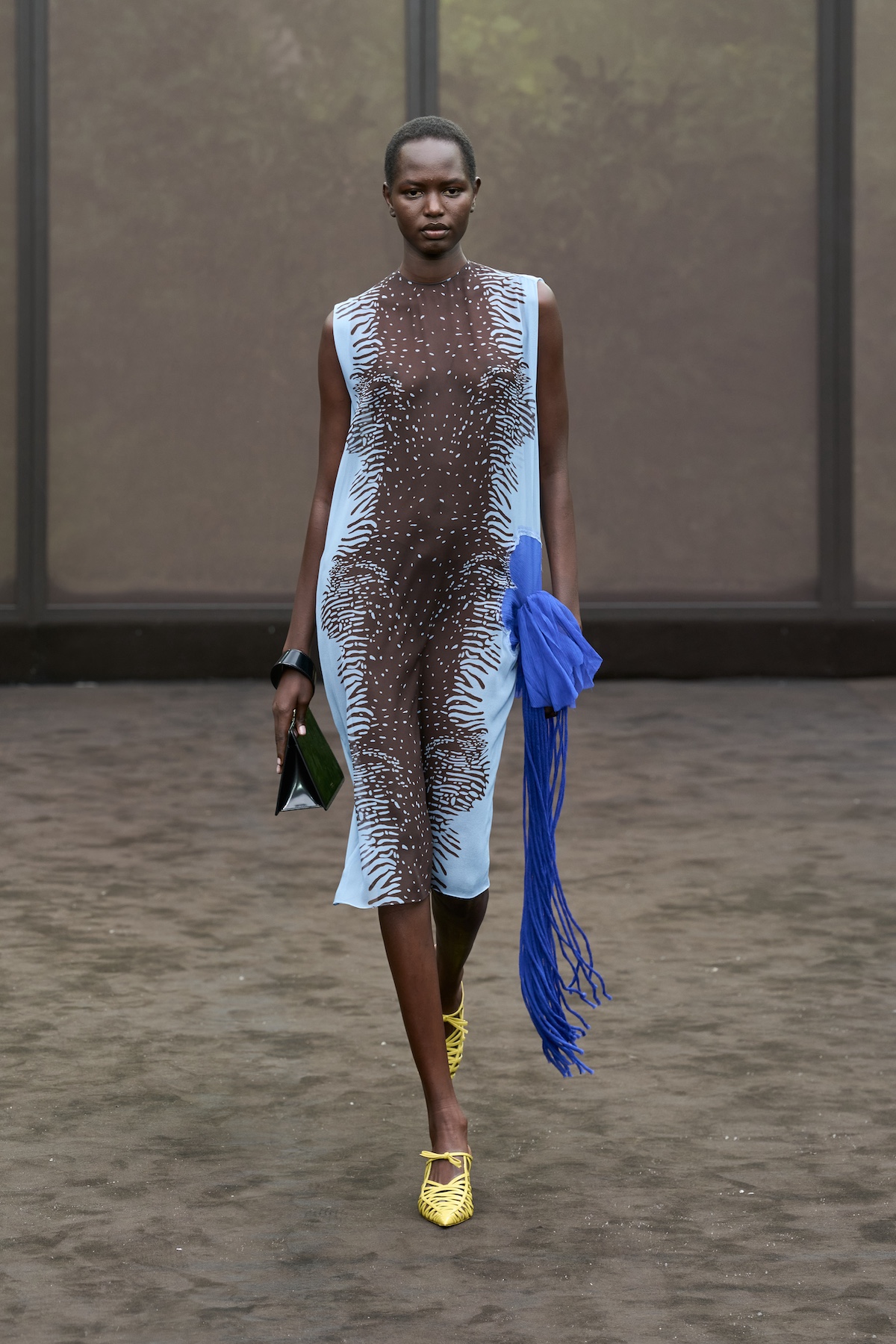
Maximilian Davis’ latest collection for Ferragamo began with a 1925 photograph of silent movie actress Lola Todd wearing head-to-toe leopard print. It led the British designer to a consideration of the adoption of ‘Africana’ by Hollywood in the 1920s, a time period that has informed Davis’s recent collections for the house (partly because it was when founder Salvatore Ferragamo was working in Hollywood, a period of fertile creativity for the Italian shoemaker; partly because it was a decade which came with a sartorial freedom, especially for women). ‘I was interested in how certain materials, prints and textiles were imported from across Africa and the Caribbean into America and Europe to become a sign of status,’ Davis elaborated, translating this mood into devoré animal prints across sinuous, 1920s-inspired dresses, while fringing and bold leather jewellery featured throughout. Tailoring, for men and women, was particularly strong this season: Davis said he had been looking at the zoot suit – particularly those worn by figures of the Harlem Renaissance – which informed the louche, blown-up silhouette. Accessories, meanwhile, captured the liberatory mood of the 1920s in their broad strokes of colour and texture – from feathered handbags to vivid satin mules. ‘This was a moment where women were creating a new femininity,’ said Davis. ‘It was a celebration of freedom, a reclaiming of self.’ Jack Moss
Receive our daily digest of inspiration, escapism and design stories from around the world direct to your inbox.

Versace
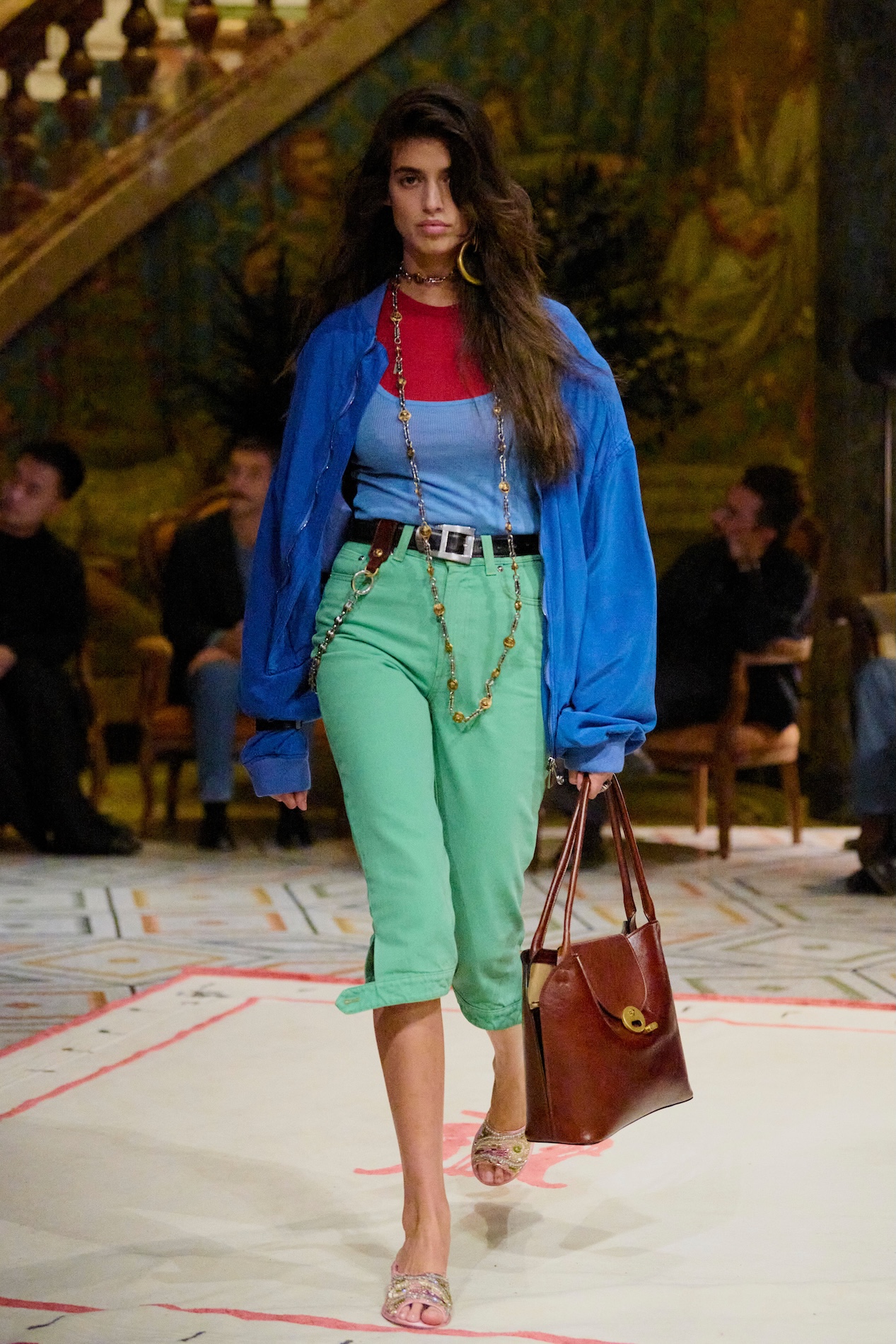
Little was known of what to expect from Dario Vitale’s debut collection for Versace – even the show itself, which took place at the Pinacoteca Ambrosiana yesterday evening, was secretive, confirmed just the day prior with a mysterious letter to attendees which instructed them to ‘wear something reckless, as though mocking propriety’. Indeed, on entering the intimate showspace at an opulent former private residence, there was evidence of a party in disarray: amid cabinets of antiques and curiosities, an unmade bed was surrounded with empty glasses, an ashtray and open packets of headache pills.
It was in this mood that Vitale – who was previously design director of Miu Miu – embraced in his first collection, one of liberated dressing, raw sensuality, and morning-after-the-night-before combinations, where glamour rubs up against reality. 1980s-inflected mini dresses scooped down the back to give a glimpse of models’ underwear beneath; vests were cut away at their sides to reveal the torso, and worn with boldly printed or striped jeans, while louche blown-up tailoring came in a multitude of brightly coloured hues. Meanwhile, Baroque prints, gold hardware and heavily beaded metallic skirts and bra tops – evocative of chainmail – were a nod to house codes.
Backstage after the show, Vitale said that he wanted to capture the spirit of Gianni Versace over direct references – as well as revealing different layers to the house beyond the glossy, va-va voom glamour with which it has become synonymous. ‘When I went to Gianni Versace’s archive, it was more about the feeling of Gianni, the feeling of this company, the feeling of the legacy of Versace, more than the pieces themselves,’ he said backstage after the show. ‘There are so many layers to celebrate, that’s what I wanted to do here.’ Jack Moss
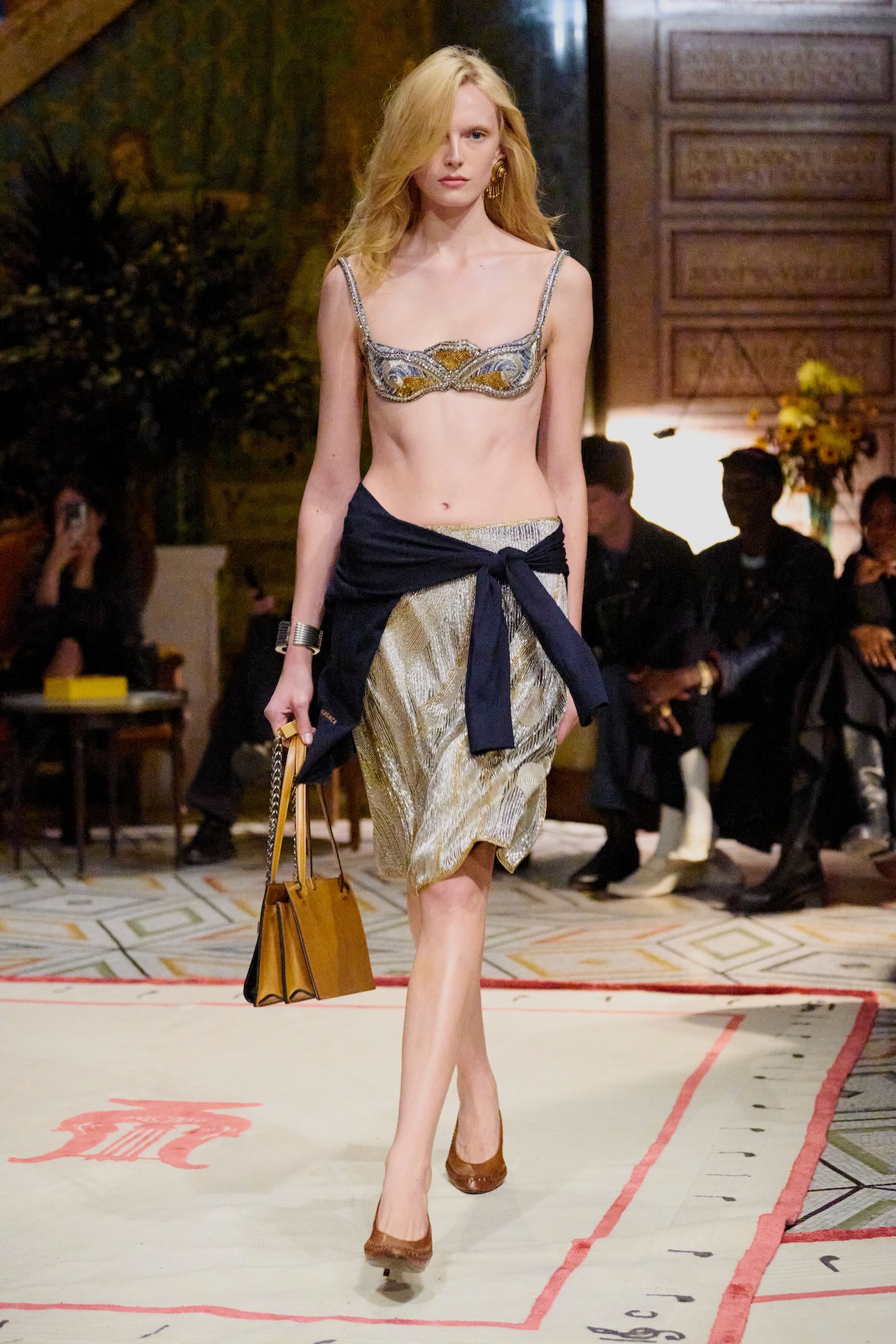
Tod’s

Since his appointment in 2023, Tod’s creative director Matteo Tamburini has been quietly building a wardrobe of modern, easy elegance for the Italian leatherwear brand. His show yesterday in Milan saw a pleasing refinement of his work thus far, unveiled with the help of a superstar cast that included Amber Valletta, Mariacarla Boscono, and Selina Forrest. Exploring the idea of ‘making your mark’, garments were made to fall and drape around the body without restriction, channeling what the designer described as an ‘essential lightness’. In practice, this saw wardrobe classics like blazers, trench coats and cabans cut in airy configurations that drew upon a springtime palette, punctuating neutral tones with saffron yellows and plenty of white. A highlight came in a series of wide-striped, asymmetrically-cut dresses and sets that referenced a 1970s sort of glamour, crafted with the formality of eveningwear in some looks and poolside ease in others. A special attention to the house’s signature material – leather – meanwhile, came in boxy leather jackets and slouchy hobo bags, while Tod’s beloved ‘Gommino’ car shoe was playfully reconfigured in a new toe-revealing sandal style. Smart, chic and wearable, it was a cohesive display from a designer fluent in the language of Italian style. Orla Brennan
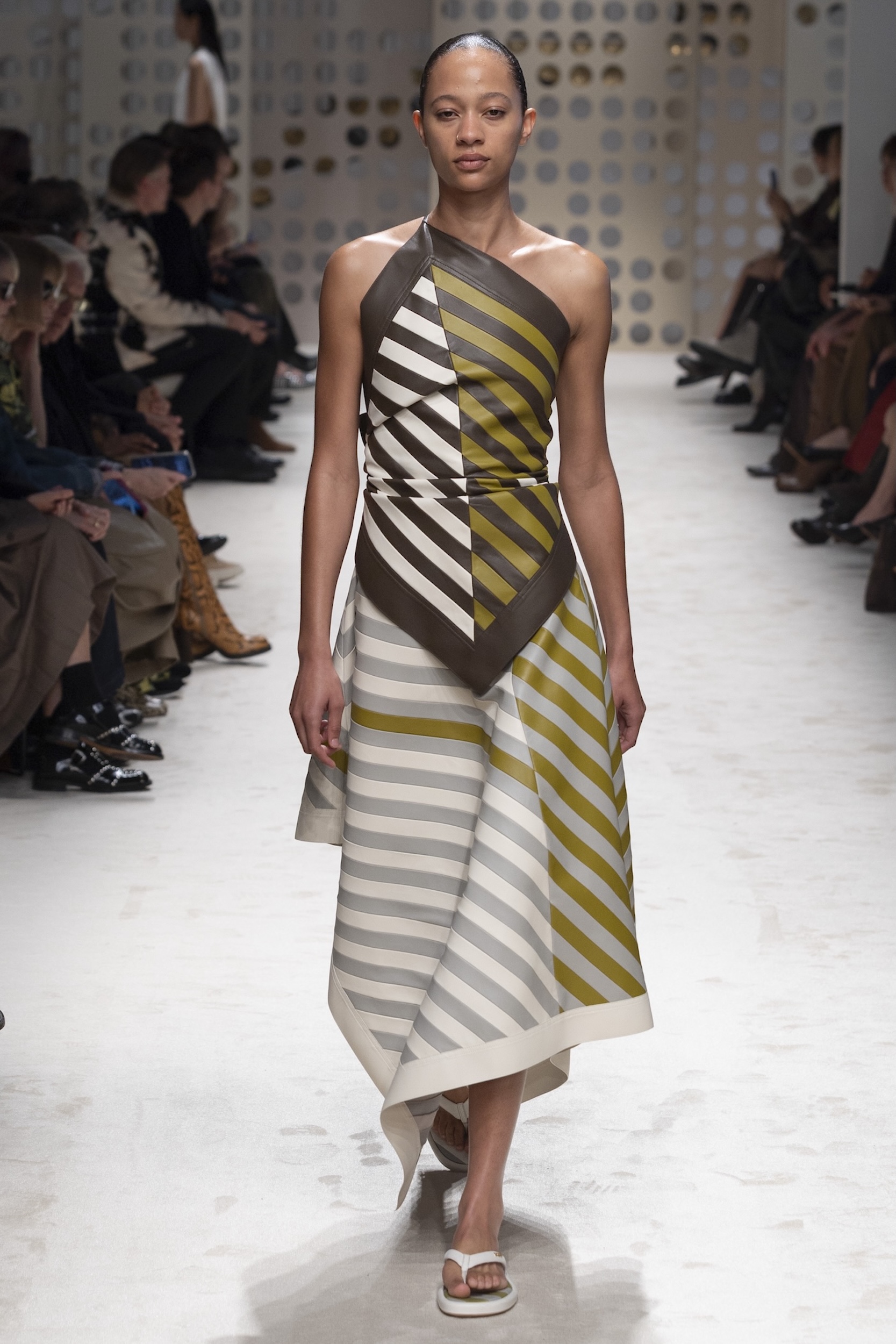
Sportmax
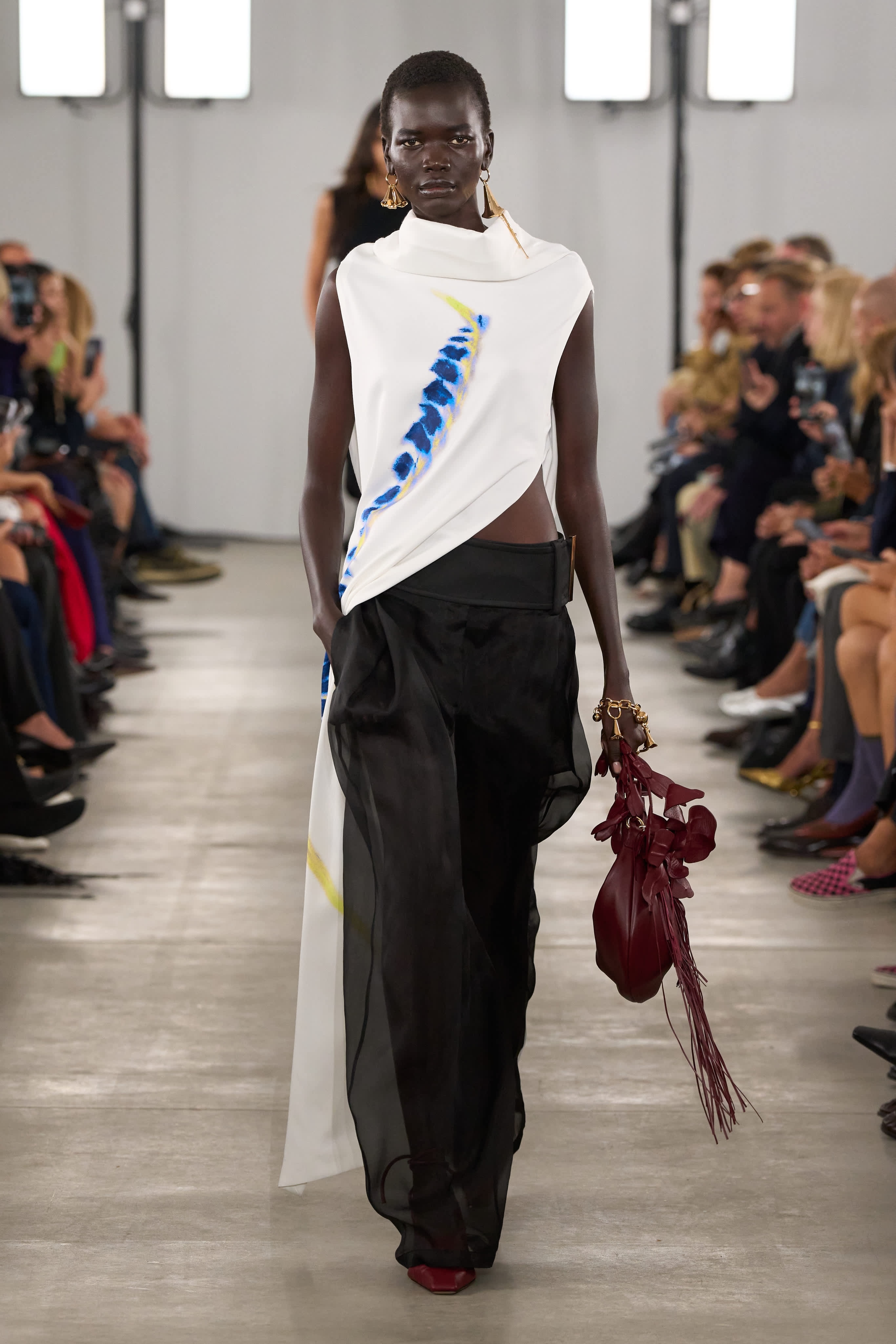
Once an enormous refrigerated warehouse, for over 100 years the Frigoriferi Milanesi has been a place of preservation: first, for foodstuffs before electrical appliances entered the home, later, for precious objects like fur coats, fabrics and fur coats, protecting them from destruction by mildew and moths. This season, the Sportmax team (which is led by a series of anonymous designers) chose the location, which is now a multidisciplinary arts and culture centre, to stage a S/S 2026 collection which attempted a similar act of preservation – to create clothing with a ‘lasting beauty’. It made for a particularly strong outing from the Max Mara offshoot which largely diverted from the more experimental mood of recent seasons towards pared-back riffs on wardrobe staples, from plays on the trench coat (they came with accentuated storm flaps and a narrow belted waistline, while others were cropped in silhouette) to tailoring re-made in sheer organza, lending lightness. Earrings and bracelets adorned with bells which rang as models walked evoked the idea of precious heirlooms, while a mood of romance came in diaphanous silk dresses printed with illustrations derived from depictions of flowers painted using Japanese cosmetics, like lipstick and nail varnish. The design team called ‘a fantasy grounded in the practical realities of urban life’ – in the bright white showspace, it felt just that. Jack Moss

Giuseppe Di Morabito
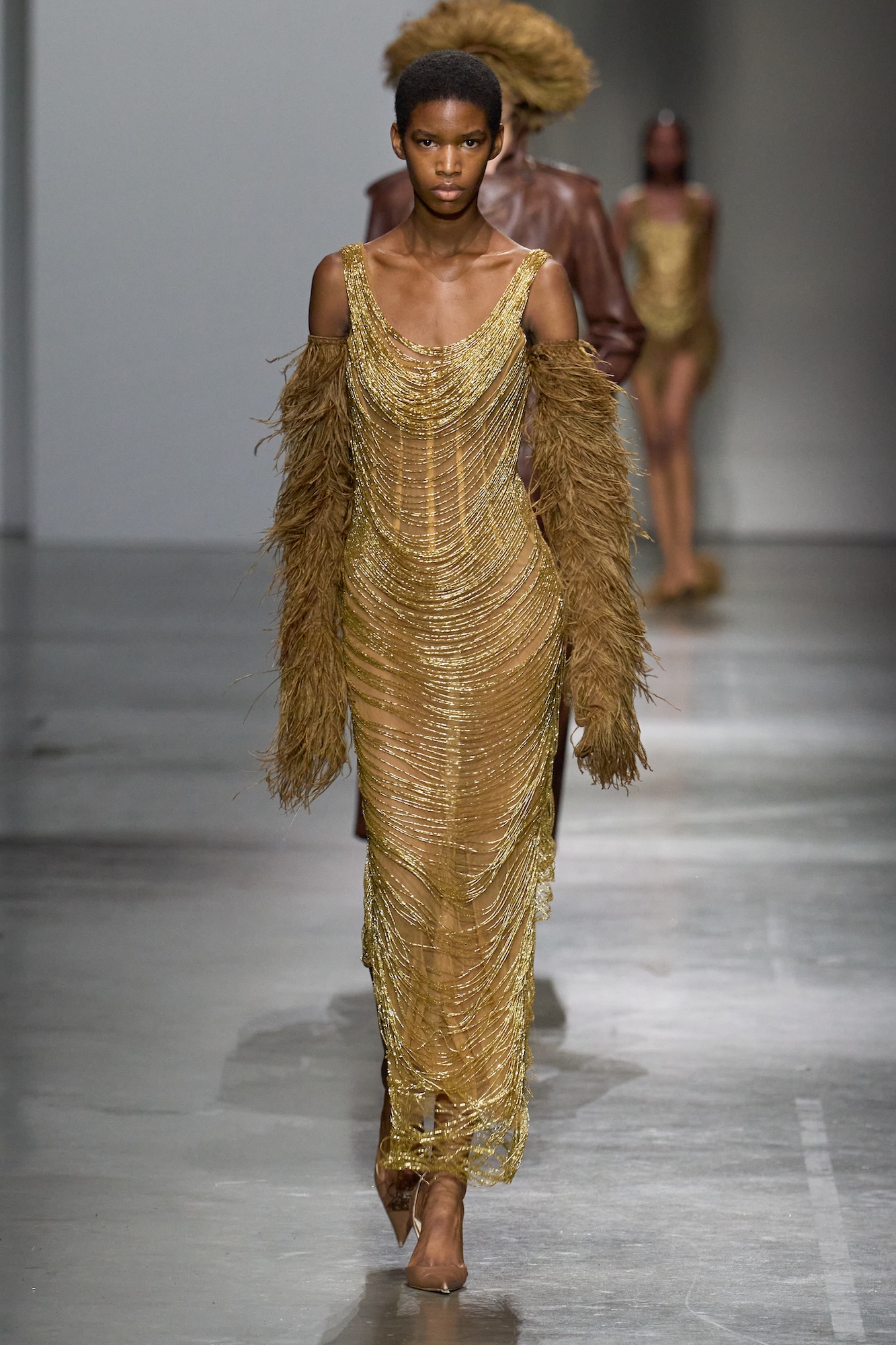
Giuseppe Di Morabito isn’t afraid to bring a bit of theatre to Milan Fashion Week. Last season, he staged a futuristic tale with a talking humanoid sculpture called Ameca at its centre, offering up a display that ‘embodied the unsettling power of technology.’ Yesterday in Milan, the Italian designer staged yet another dramatic performance, this time telling the age-old myth of Icarus. Imagining the ‘perilous risk of the fall,’ dancers were suspended from the ceiling as a cinematic soundtrack created by AI played through the room. Beneath them came Di Morabito’s models, dressed in silhouettes inspired by relics of ancient times: porcelain corsets detailed with roses, macramé encrusted with glistening stones, crystal-adorned armour and dresses crafted from pearls. A few models wore wings forged from metal. Throughout, a close attention to the body appeared in various expressions – from fragile pieces crafted from stockings to frayed lace on waist-snatching bodices, grounding the collection in the designer’s love for the art of corsetry. The show, said the brand, marks a new chapter whereby each collection will be a continuation of the last, building a story that expands season by season. Where the tale turns next, only Di Morabito knows. Orla Brennan

MM6 Maison Margiela
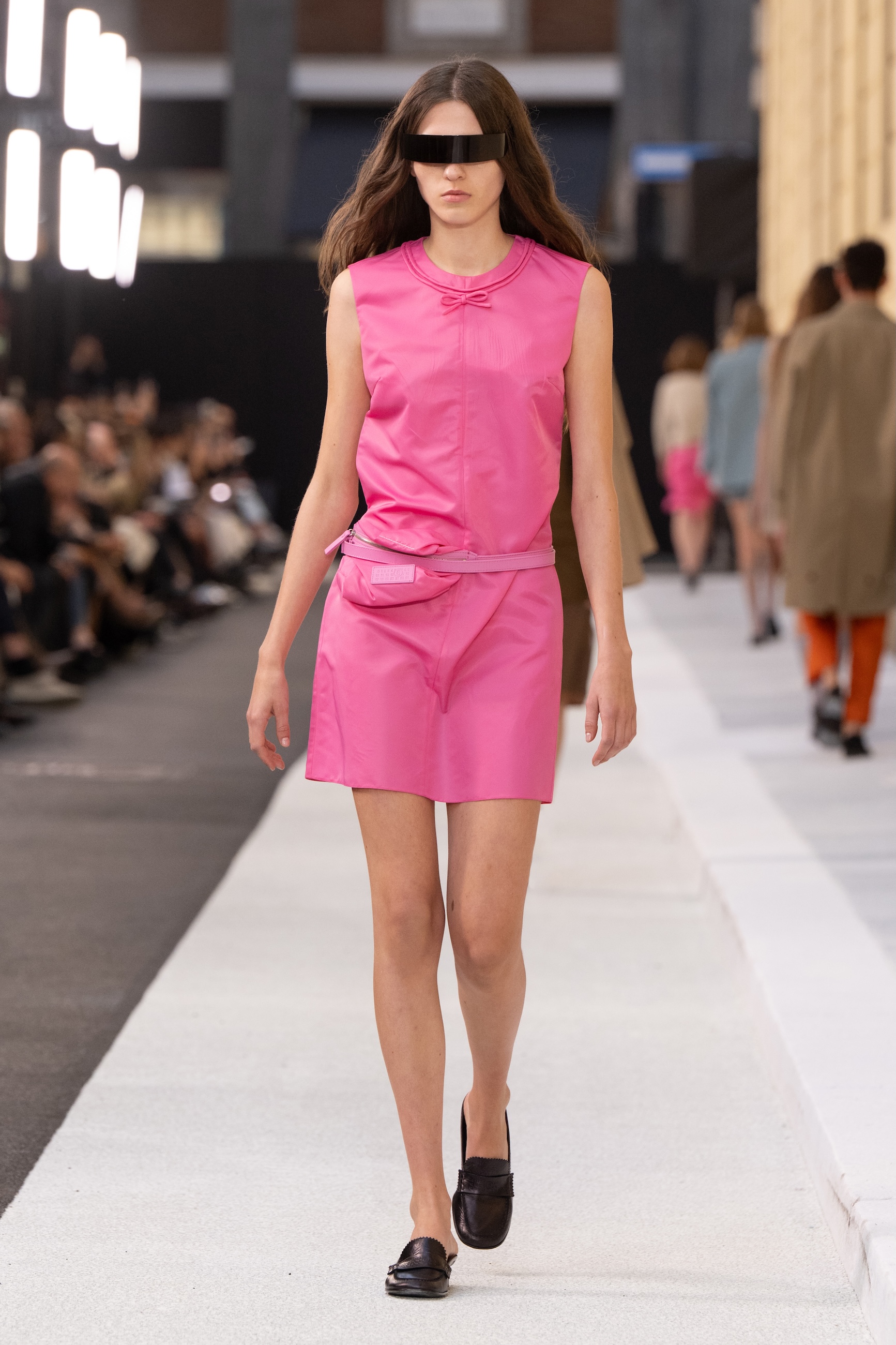
Last night in Milan, the MM6 show was a reminder that often the best examples of style are glimpsed on city streets. In lieu of a runway, the anonymous studio team behind the Maison Margiela diffusion line painted a path on the pavement in the house’s signature white. Models came past in a flurry of Post-it note colours that shuffled up ideas of the contemporary wardrobe. Silhouettes were streamlined and hemlines short, while transparent inserts, trompe l’oeil cutaway shapes, and end-of-fabric roll raw hems nodded to the house’s deconstructed codes. The styling of the show leaned into a feeling of eclecticism, with 1960s-style twinsets, classic macs, shirting, and tailoring jumbled with denim – one of MM6’s strongest categories (this season, appearing in formal cuts that took after suit trousers). Accessories, meanwhile, added glimmers of the surreal, including shiny metallic flats, futuristic strip sunglasses, and jewellery that mimicked cocktail glasses. Channelling the idea that ‘impromptu is the law’ on the street, the display was a fresh love letter to city dressing, fittingly staged in one of the world’s great style capitals. Orla Brennan
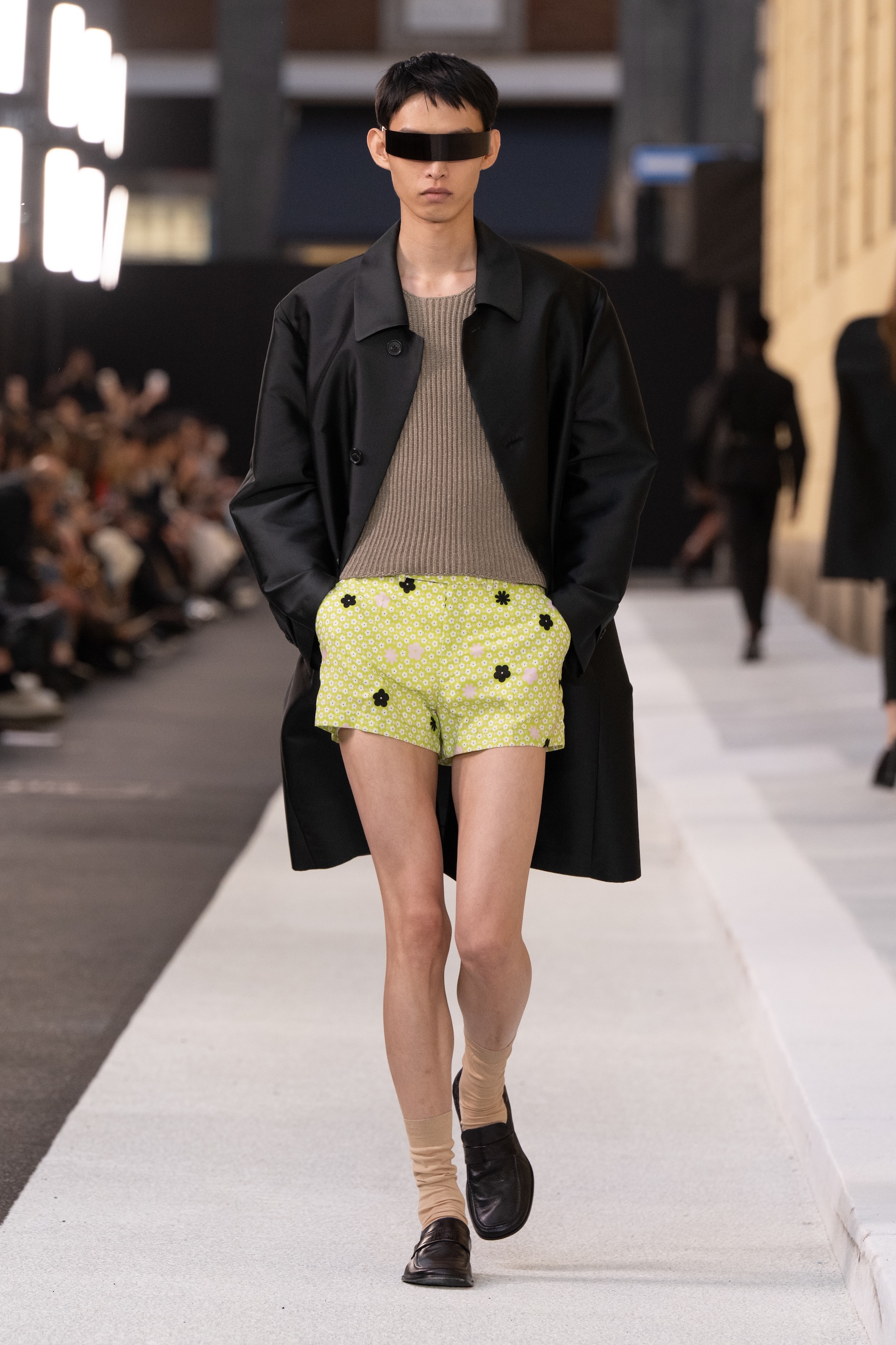
Max Mara
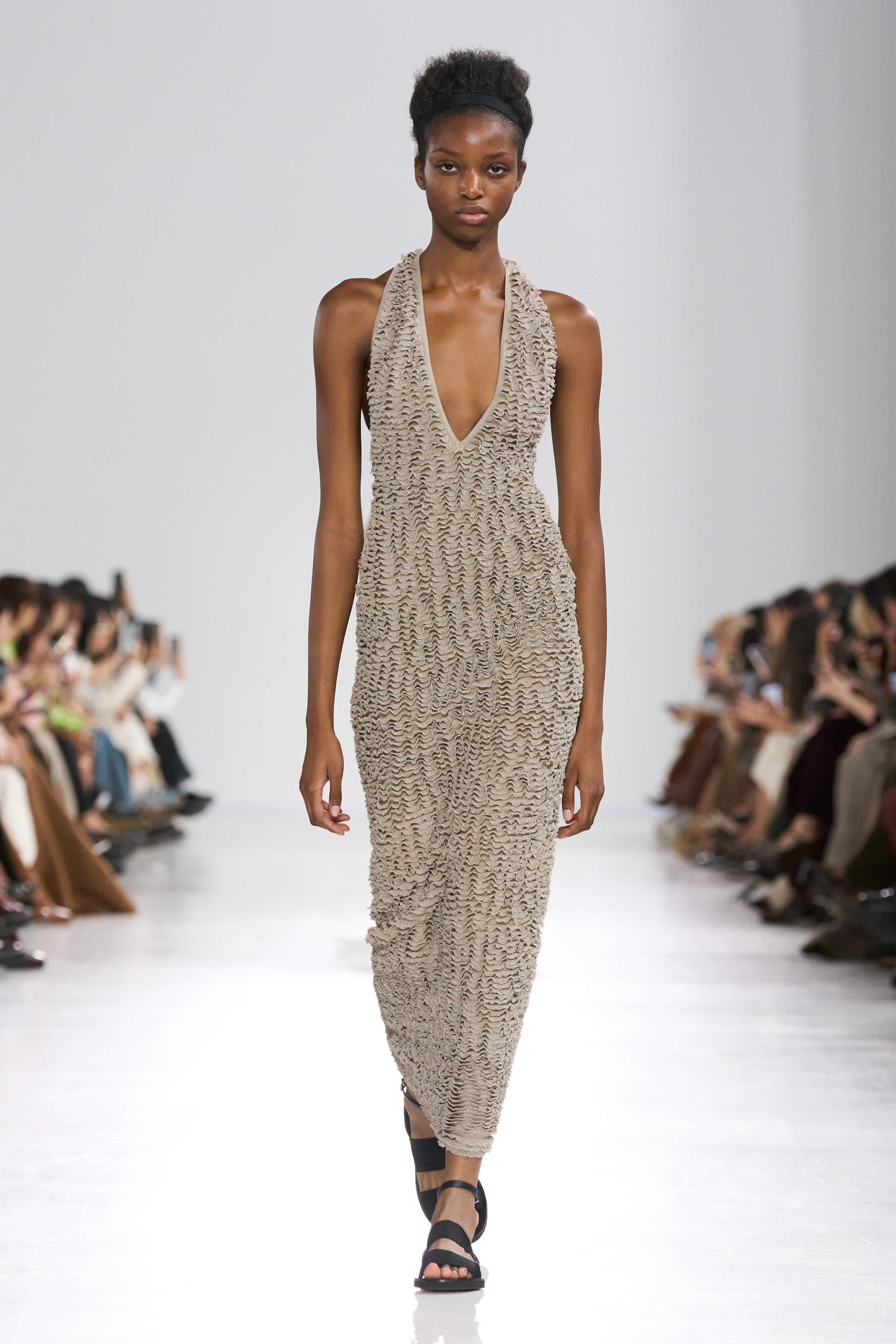
Madame de Pompadour, the influential mistress of French monarch Louis XV, was the latest to be inducted into the ‘pantheon’ of Max Mara women, a series of notable female figures from history that creative director Ian Griffiths looks to for inspiration each season. Praising her intellect, power and wit – as well as her links with the great thinkers of the day – she inspired a S/S 2026 collection which the British designer called ‘Rococo Modern’. Drawing a link between the opulent flourishes of Rococo and the New Romantic movement of the 1980s (of which he was a part, as evidenced by a photograph of himself from the period on his moodboard for the season), the collection fused dramatic flourishes – a twisted ‘corona’ sleeve on a trench coat; fluttering ‘petals’ of organza; opulent floral brocades – with the sleek, reduced wardrobe of the Max Mara woman. Elsewhere, Madame de Pompadour’s signature coif was referenced in the hair, here held in place with a thick black band – a motif which also appeared on narrow black belts which looped around models’ waists, exposed by midriff-bearing tailoring. Jack Moss
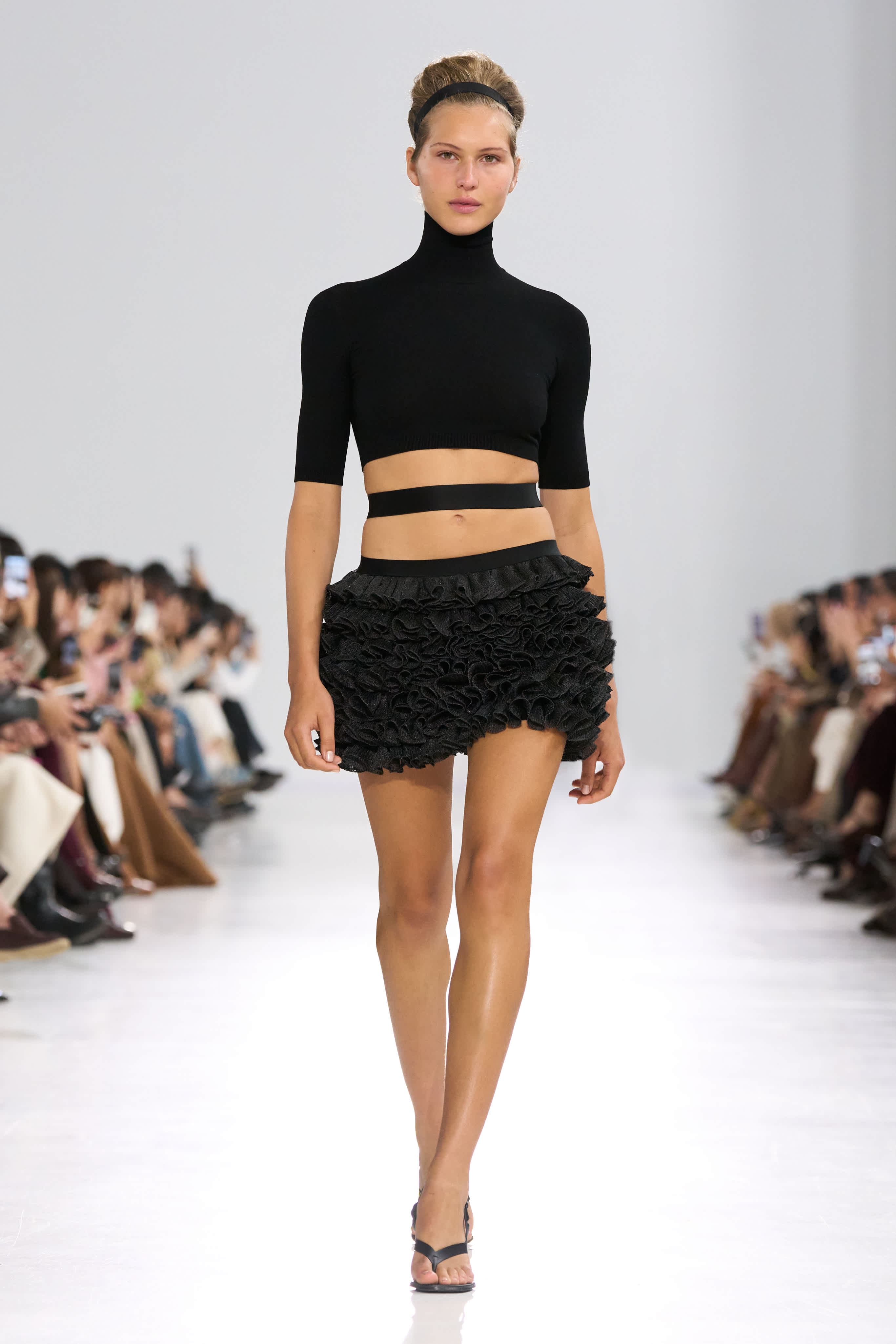
Prada
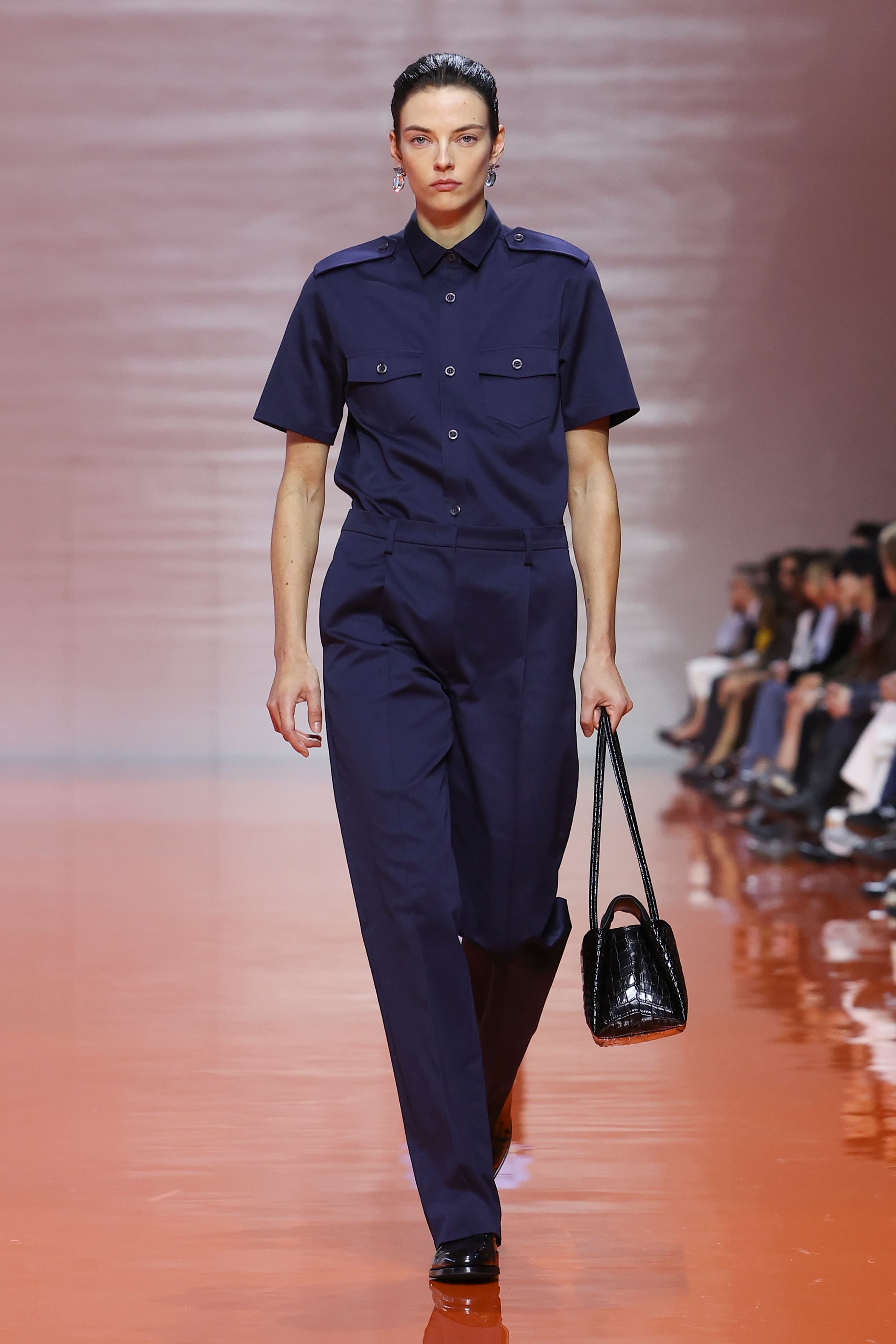
Miuccia Prada and Raf Simons continue to grapple with the information onslaught of contemporary living: how can we find freedom in our algorithmic age? A sequel to the house’s menswear show, presented in June of this year, the setting was the Deposito at Fondazione Prada, once again stripped bare of the usual elaborate sets and the upper windows revealed to let the light in. A vast lacquered floor, in vivid orange, provided the only adornment to the space, suggesting at once a feeling of uplift and something more industrial – it was close to international orange, the hue is used in air safety and engineering. The opening look was a riff on the uniform: a military shirt with epaulettes, pleat-front pants and black leather work shoes (albeit here worn with gobstopper, candy-hued earrings and a mock-croc handbag).
It was from this starting point – the uniform – that the pair diverted, seeking to build what Mrs Prada described backstage as ‘a new kind of elegance’. ‘In a uniform you are protected, you are neutral, it allows you to think,’ added Simons, the collection exploring the idea that you can feel as dressed up – or indeed as powerful – in a uniform as a dress, or vice versa. As such, moments of glamour were interjected – a juxtaposition to the sober working uniform – from opera gloves to flourishes of gems and crystals, or ballooning protusions of colourful taffeta. There was an idea of collage to spliced-together skirts that featured panels of ruffles and pleats, while others had straps that looped over the shoulder in what the pair called a re-examination of the perennial elements of a woman’s wardrobe (draped bra tops followed a similar rationale, seeking ‘shape without structure’).
‘The future is unknown. This collection is about reacting to the uncertain – clothes that can shift, change, adapt. In the combination of the different elements, in this idea of composition, there is a choice and freedom, authority and agency for the woman wearing them,’ said Mrs Prada of the collection, which came down to the idea of female autonomy – or indeed, human autonomy, to make a choice amid the noise of contemporary living. ‘There is the licence to combine different elements, to compose, and there is also a physical liberation, moving away from fashion as a sculptural imposition on the body of a woman,’ added Simons. ‘We shifted into the opposite – physical emancipation, but also freedom as a state of mind.’ Jack Moss
Read our full Prada S/S 2026 show report
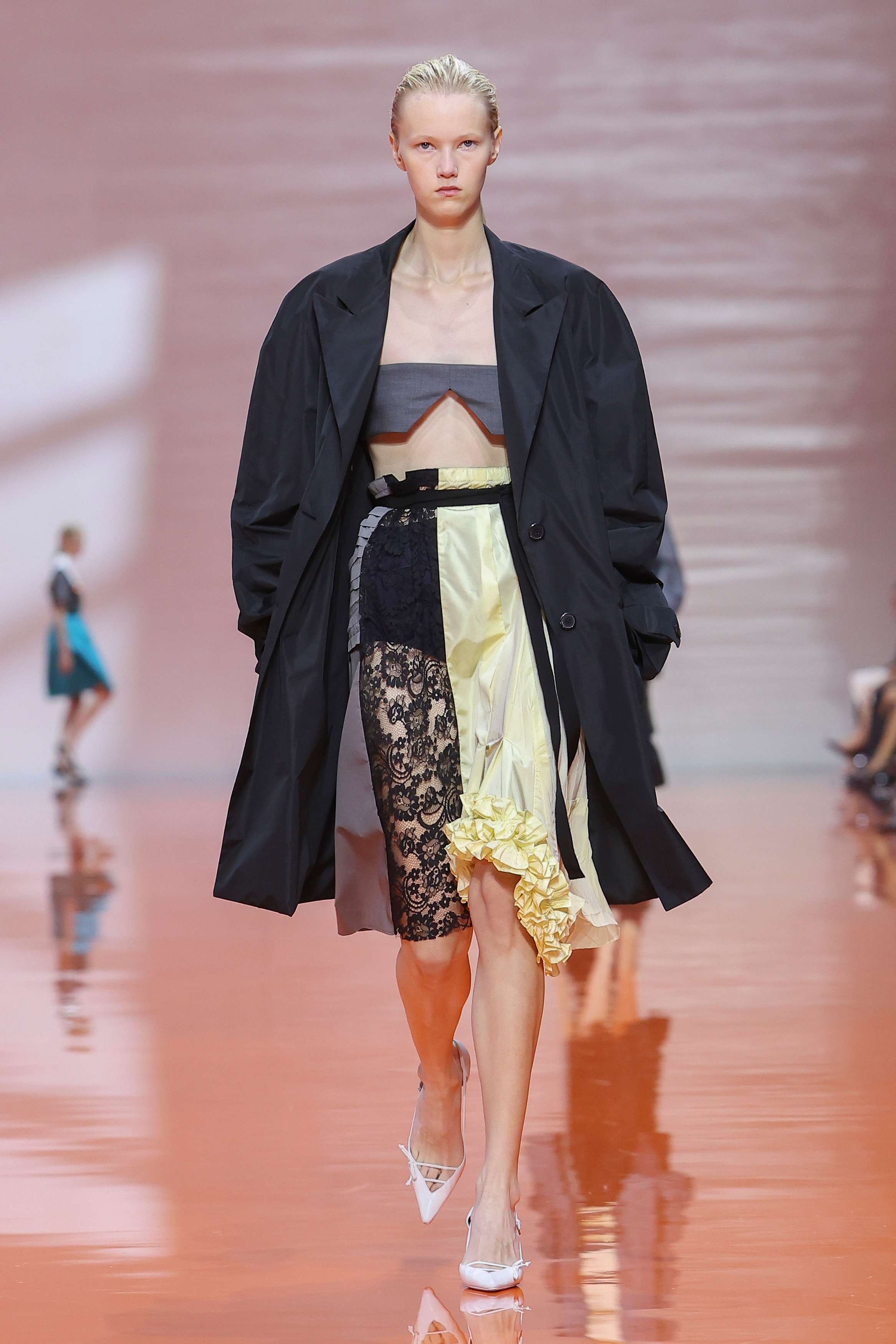
Emporio Armani
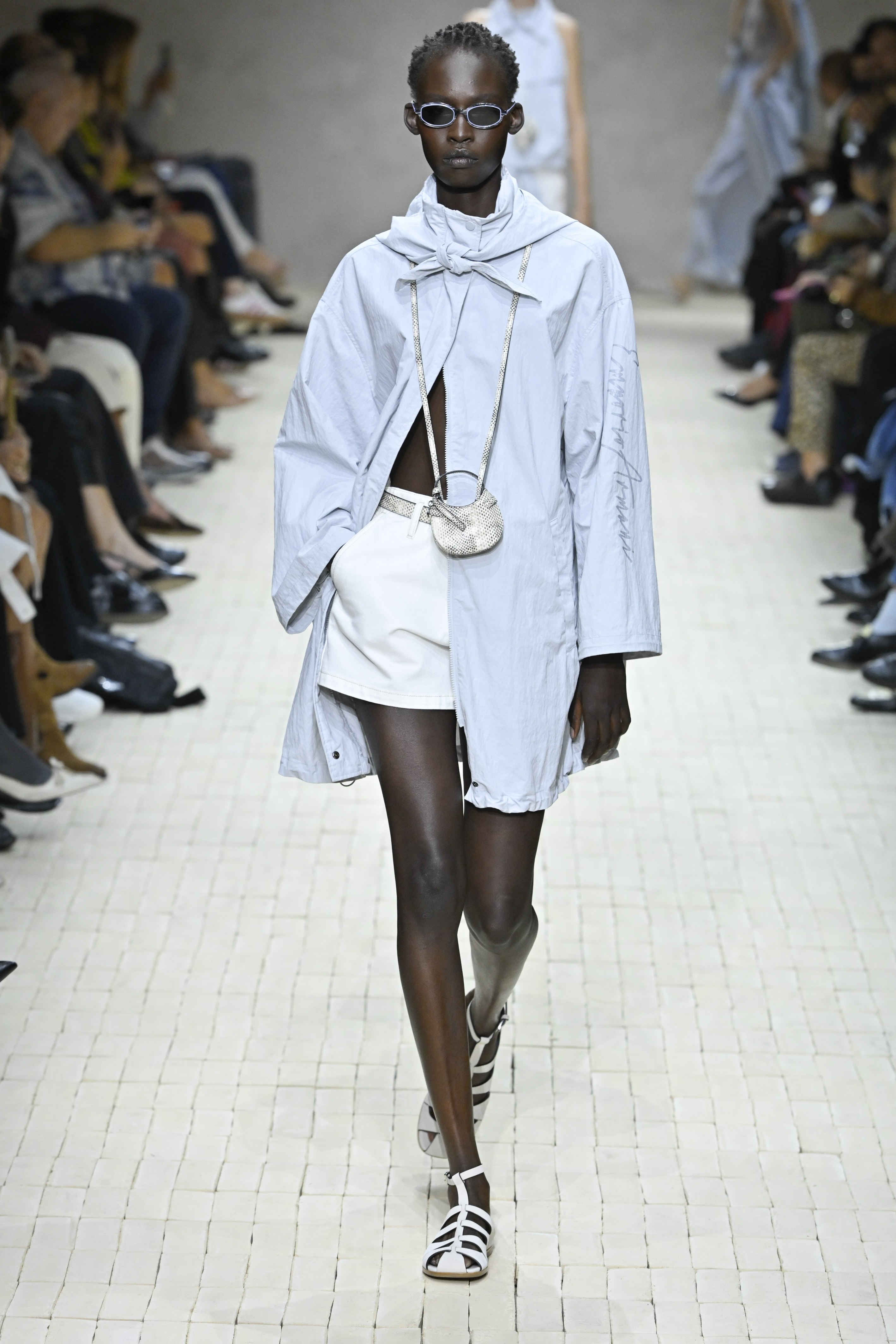
In the first of two collections to be shown this week that were created by Giorgio Armani prior to his death earlier this month, aged 91, Thursday afternoon’s Emporio Armani show was an understandably emotional moment – a swansong for a designer who changed conceptions of Italian style and built a fashion empire (the future of which is still being decided: Mr Armani instructed in his will for it to be gradually sold off to a luxury goods conglomerate, his preferences being LVMH, L’Oreal, EssilorLuxottica or another of ‘equal standing’). Continuing his louche vision of elegance, inspired by the idea of travel (the set once again evoked his beloved Pantelleria), the collection featured breezy and diaphanous tailoring in hues of Armani greige, while obi-belt fastenings – worn over dresses – continued a lifelong fascination with Japan and its ritual dress codes. A glimmering final act, meanwhile, had a party spirit – crystallised bikini tops and sheer sequined T-shirts would not look out of place in an Ibiza nightclub. The show ended not with Mr Armani’s usual runway bow, but with the gathered attendees turning towards an empty runway exit where he once would have stood. From there, rousing applause and a standing ovation – one which will no doubt continue on Sunday, with the presentation of the designer’s final collection for Giorgio Armani, at Pinacoteca di Brera art gallery. Jack Moss
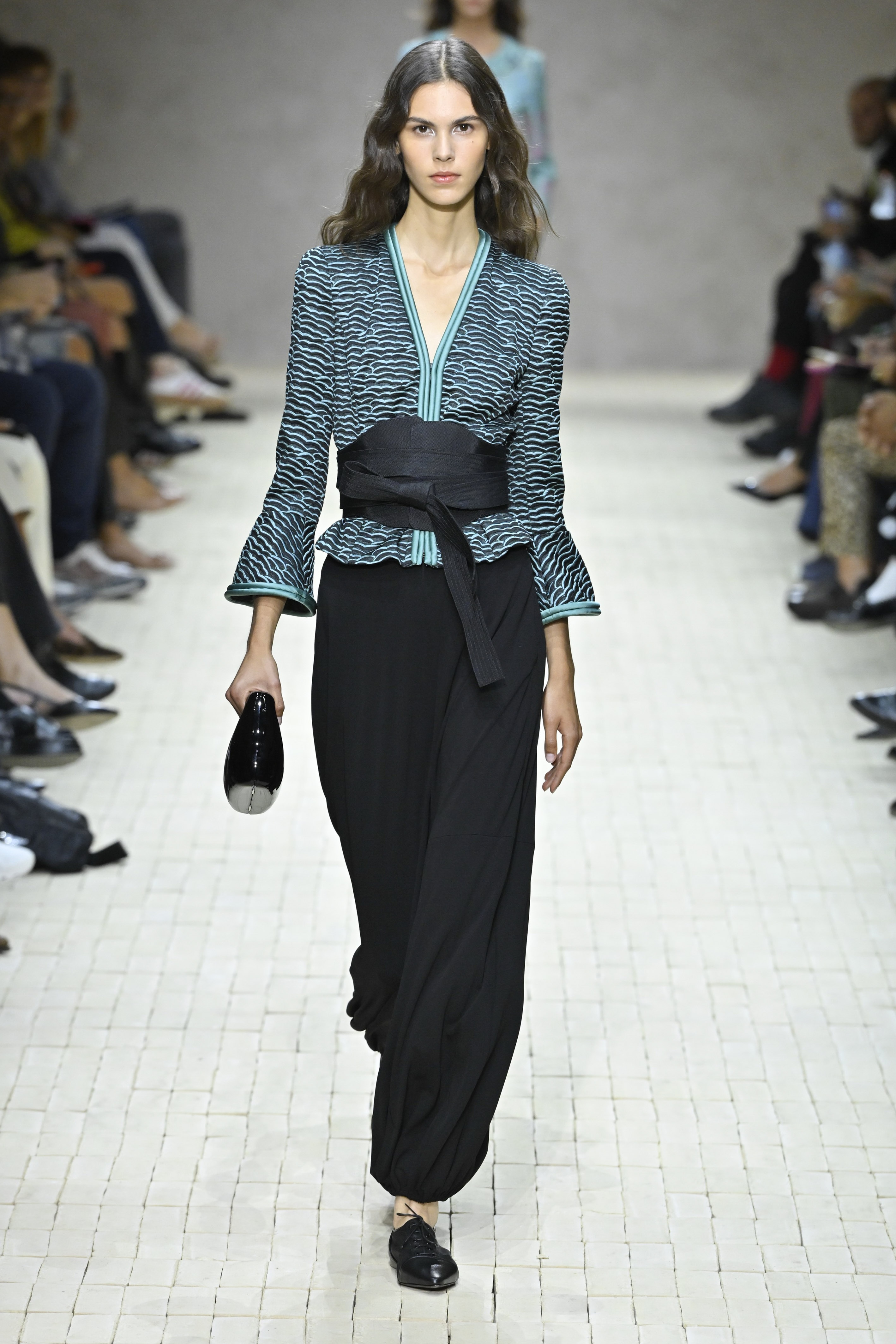
KNWLS
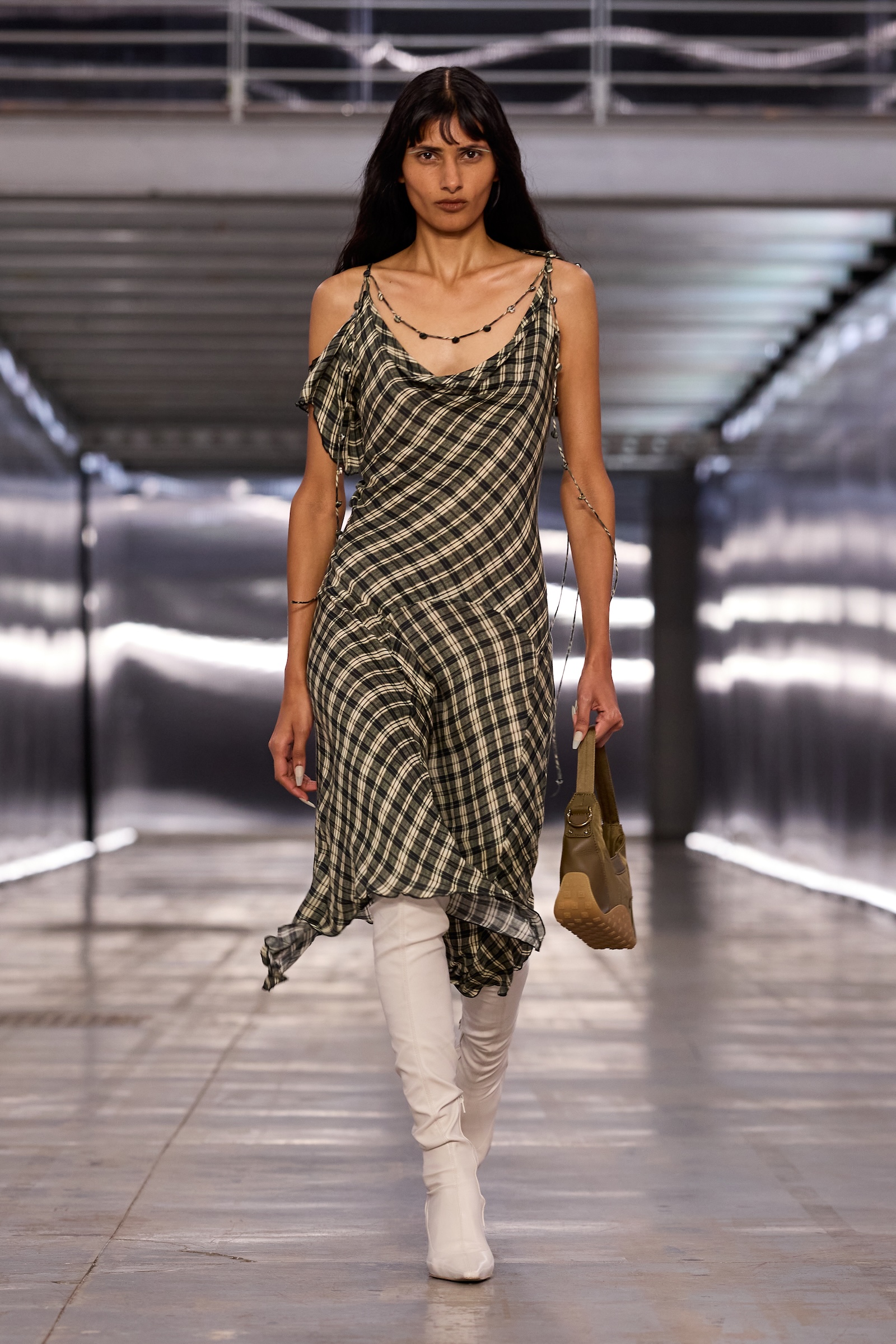
Usually an adrenalised highlight of the London Fashion Week calendar – showing in dimly lit underground car parks and warehouses – KNWLS has decamped to Milan for the first time in its history. Led by namesake Charlotte Knowles and her partner in work and life, Alexandre Arsenault, the move marks a defining step up for the brand as it joins fashion’s global heavyweights. KNWLS used the moment to debut a collaboration with Nike, merging its unabashedly sexy codes with the sportswear juggernaut’s breadth of technical resources. A collection of ‘fearless sensuality’ that moves from gym to club with ease, KNWLS signatures – corsetry and sensually cut cycling shapes – came in scuba-style tops, Nike Flyknit corsets, languid button-down dresses, and slinky tapered leggings crafted in Tencel fabrics. Accessories, meanwhile, saw models sling new nylon and leather versions of the popular ‘Razr’ bag – now finished with a rubber base inspired by Nike’s first waffle outsole – over shoulders, while vintage football shoes informed corset-laced reworks of the Air Max Muse. Elsewhere, severe leather outerwear with domed shoulders and cinched waists created an armour-like figure for the KNWLS woman this season, while a brown tartan storyline in floating dresses and strap-detailed, low-slung mini skirts reminded of the breakthrough designs that first put KNWLS on the map in the late 2010s. A celebration of the south London brand’s raw spirit at a pivotal point in its trajectory, the high-octane Milan display proved you can take KNWLS out of London, but you can’t take London out of KNWLS. Orla Brennan

Jil Sander
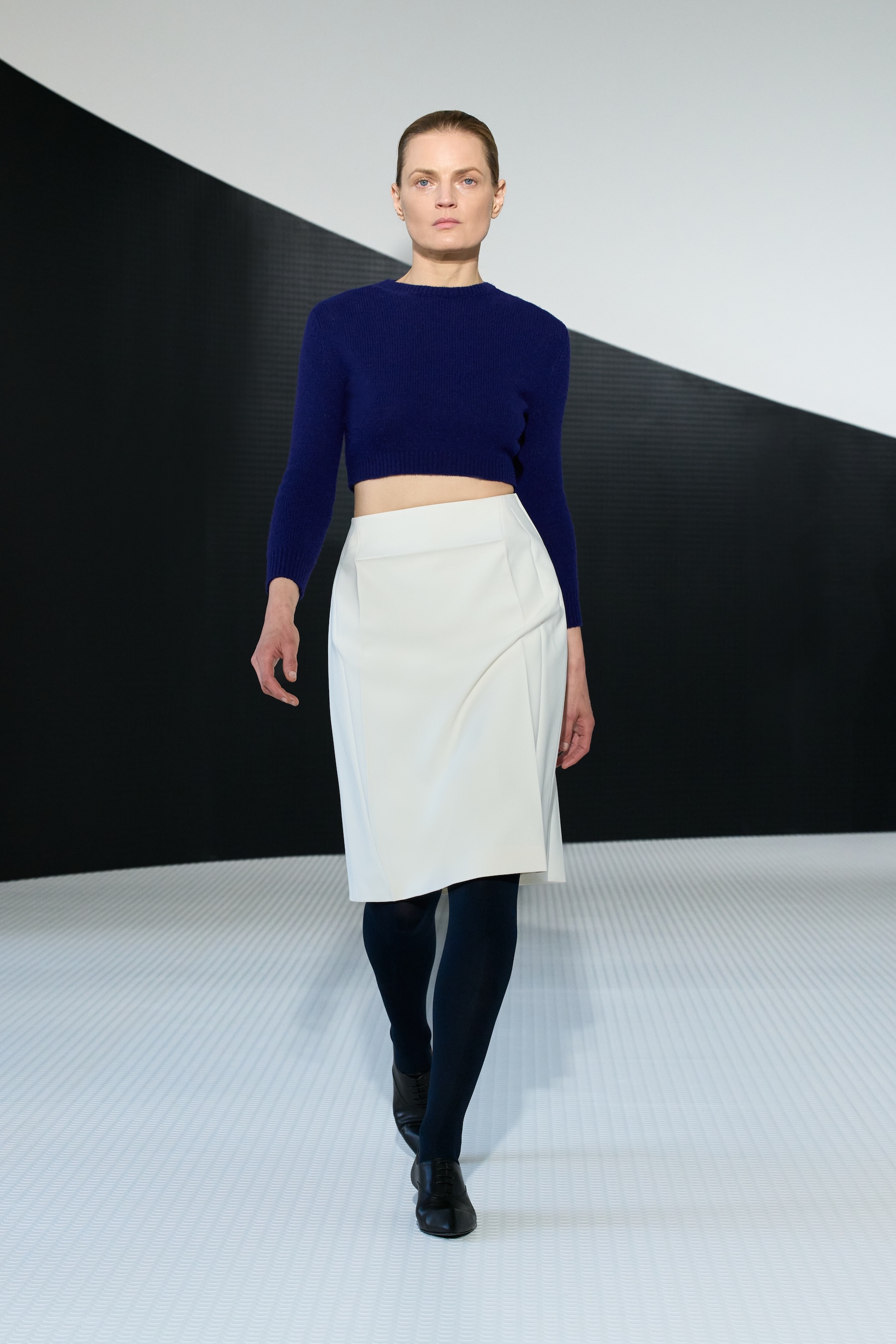
Simone Bellotti chose Jil Sander’s headquarters on Piazza Castello for his debut show as creative director, a choice which suggested a homecoming. It has been eight years since the brand has shown here, with Bellotti’s predecessors, Lucie and Luke Meier, choosing to show at other locations across the city. Arriving at the minimalist headquarters, which had been installed with a ramped black runway for the occasion, there was plenty of anticipation: over a short but impactful tenure at Bally, Bellotti has become known as the fashion editor’s favourite designer. He may not have garnered the column inches of some of his more well-known contemporaries, but he has an eye for great clothes (and accessories) with enough of a twist to keep them fresh.
This continued here: opening with Guinevere Van Seenus – a longtime face of the label, appearing in some of the brand’s most memorable campaigns – the collection was a streamlined offering for men and women that returned to the idea of reduction synonymous with the brand’s namesake designer (Sander was a master of stripping away the extraneous; as such, she remains forever linked with 1990s minimalism). Tailoring was a highlight: jackets and overcoats were cleverly constructed to nip the contours of the waist, or came with shortened lapels, while skirts were slashed across their front, Lucio Fontana style. Moments of vivid colour across shrunken, colour-blocked knitwear felt particularly Jil Sander, while accessories were strong: from intriguingly shaped lace-up shoes with tiny in-set kitten heels to crescent-shaped handbags, there was plenty to desire here.
‘[It’s] a balance between structure, tailoring, and classicism, and modernity and lightness,’ Bellotti said post-show. ‘Trying to reveal the body in a subtle way. I really think Jil Sander has always had these two elements.’ In this balance, Bellotti struck a note of rare clarity that seemed to resonate. Afterwards, the mood was buoyant: consensus was that these were clothes you wanted to wear, now. And in a sea of debuts, that’s enough to stand out. Jack Moss
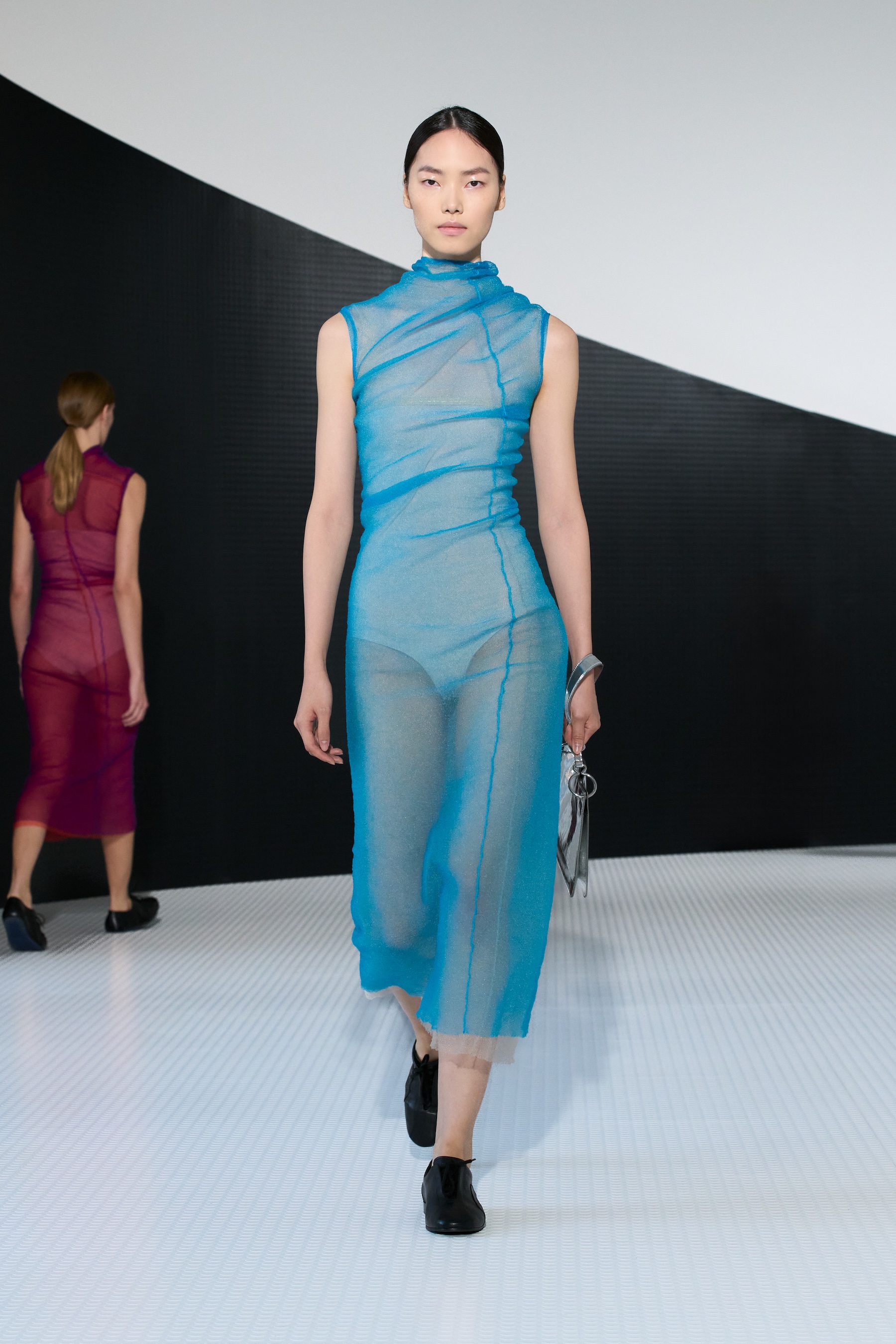
No.21

Alessandro Dell’Acqua is something of a film fanatic – an obsession that has trickled into his cinematic ideas of womanhood throughout his years at Brioni, Rochas, and latterly at his own brand No. 21 (named after his birthday and lucky number). Last season, it was the evocative worlds of Sofia Coppola that inspired the Italian designer, with scenes from Marie Antoinette and The Virgin Suicides informing a collection that offset expressive bow-shaped motifs in heavy wools with the girlish naivety of pastel-hued slip dresses. This season, however, the designer’s thoughts were on real life. Listening to the news each day, he began to question the superfluous role of a fashion designer amid a world in crisis.
Not a political statement, but an affirmation of his love of his craft – and of carrying on when things feel meaningless – the resulting collection he presented in Milan last night dug down into his design obsessions. A desire for lightness came in heat-pleated duchesse silk, airy polka dot dresses of a 1940s feeling, sensual side-slit sheer chiffon skirts and sweet cotton poplin shorts and shirting. Layering up pieces in playful configurations, colours and textures, meanwhile, evoked a feeling of chic eclecticism – mixing various forms of tartan, nostalgic florals, shiny metallic skirting and soft cashmere knitwear, thrown around models’ shoulders with a sense of ease. ‘I chose to forgo all symptoms of nostalgia, transforming them rather into a choral tale of experiences of fashion and design,’ the designer said following the show. Orla Brennan
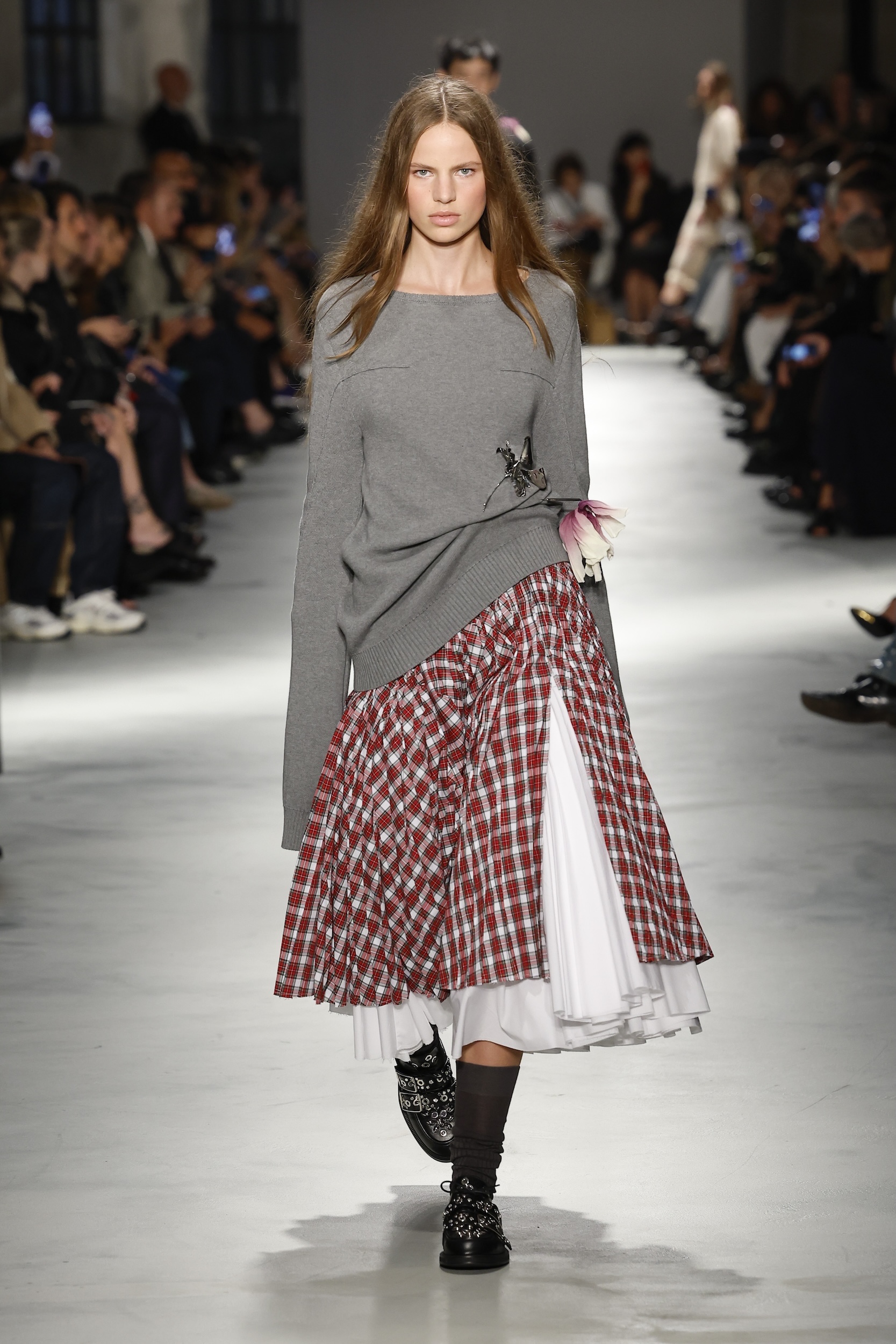
Fendi

Silvia Venturini Fendi continued to have fun in her second season overseeing Fendi’s men’s and womenswear collections with an uplifting S/S 2026 show at the brand’s headquarters on Via Solari (previously heading up menswear and accessories, since the departure of Kim Jones last year, she has taken over the women’s collection as well). Staging her show amid a playful runway set by Marc Newson, comprising stacks of colourful blocks on which audience members perched, the designer said she was thinking about the idea of a ‘future summer’, translating moments of nostalgia into a sleek, contemporary vision. It made for an eclectic outing, with sportswear elements coming to the fore: ladylike pleated skirts and dresses had been reconstructed with adjustable toggle fastenings, while the sweatsuit was instilled with new glamour (crafted from sheer fabric, it came with slices of shearling across the jacket and pants). Colour was also vivid – a psychedelic palette matched Newson’s set – meeting moments of embellishment and pattern, from clusters of paillettes and lace motifs to 1960s-style flowers, cut out of garments. Particularly appealing were the accessories: enormous woven totes came in primary hues, while a version of the ‘Peekaboo’ flipped open to reveal a sequin-lined interior – the kind of surprise that Venturini Fendi loves. Jack Moss
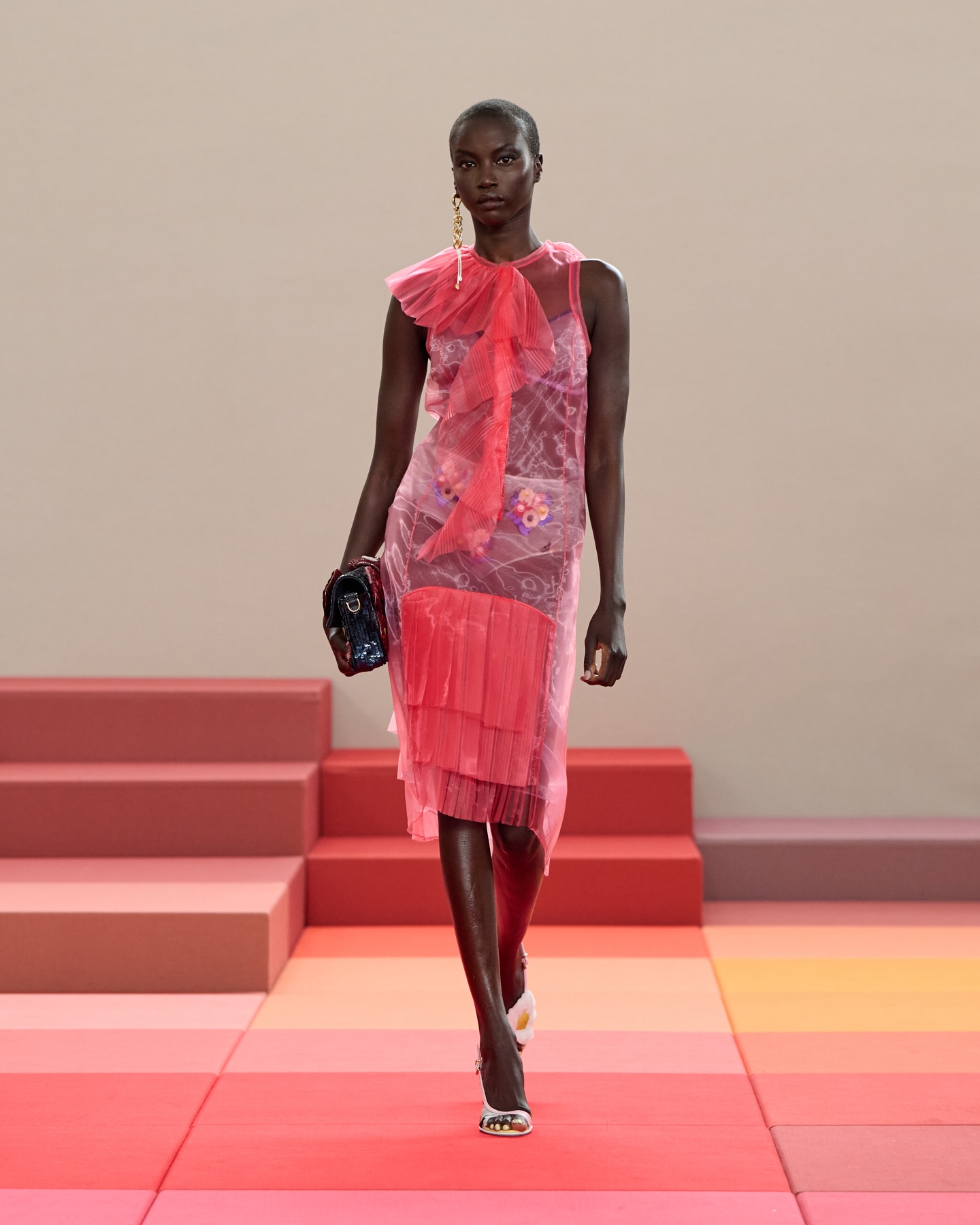
For more of the week’s latest happenings, see our Milan Fashion Week live blog
Jack Moss is the Fashion Features Editor at Wallpaper*, joining the team in 2022. Having previously been the digital features editor at AnOther and digital editor at 10 and 10 Men magazines, he has also contributed to titles including i-D, Dazed, 10 Magazine, Mr Porter’s The Journal and more, while also featuring in Dazed: 32 Years Confused: The Covers, published by Rizzoli. He is particularly interested in the moments when fashion intersects with other creative disciplines – notably art and design – as well as championing a new generation of international talent and reporting from international fashion weeks. Across his career, he has interviewed the fashion industry’s leading figures, including Rick Owens, Pieter Mulier, Jonathan Anderson, Grace Wales Bonner, Christian Lacroix, Kate Moss and Manolo Blahnik.
-
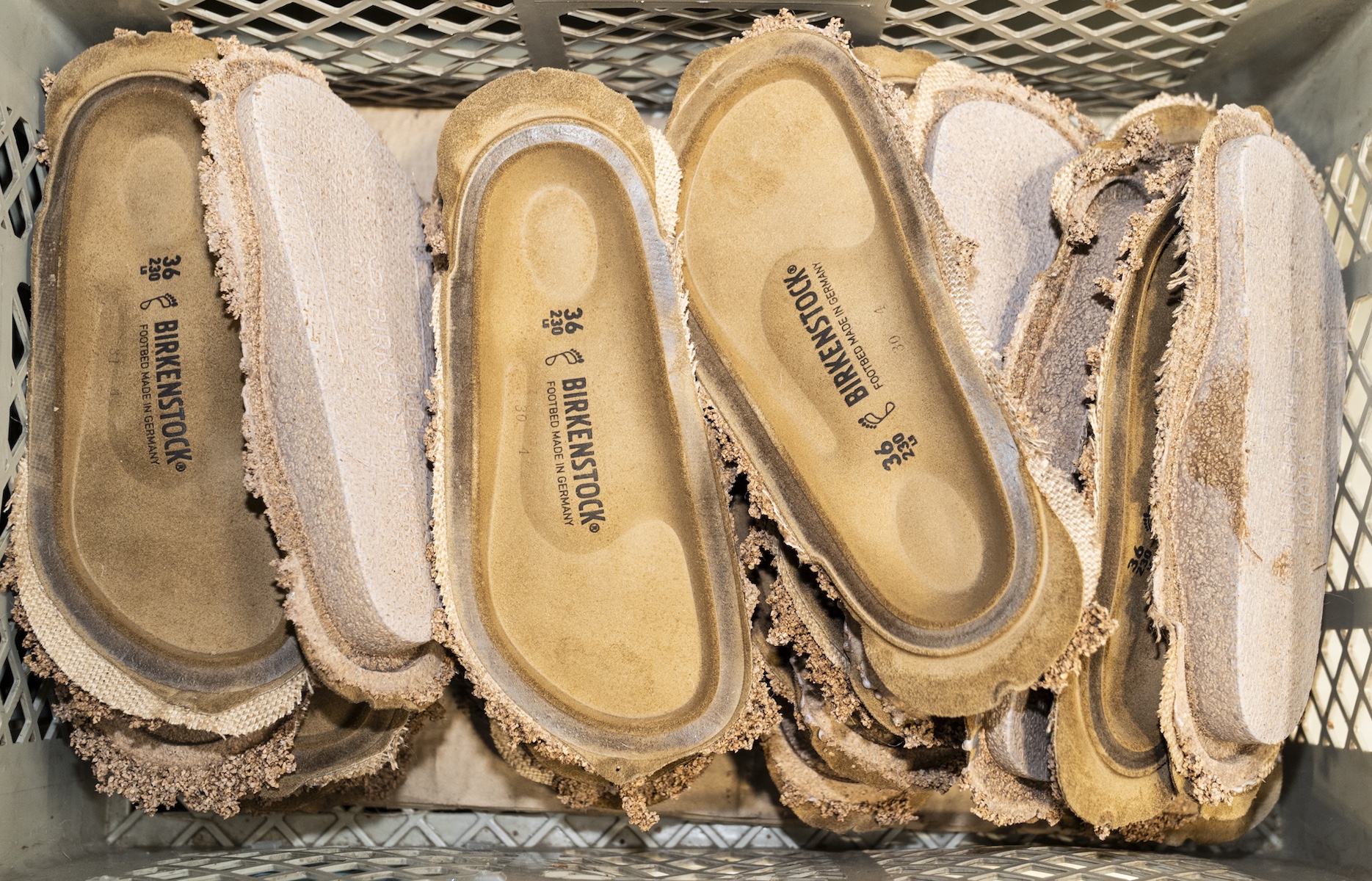 Inside the factory where your Birkenstocks are made
Inside the factory where your Birkenstocks are madePart high-tech laboratory, part artisanal workshop, the German factory straddles past and future. For Wallpaper*, Stuart Brumfitt takes a rare tour
-
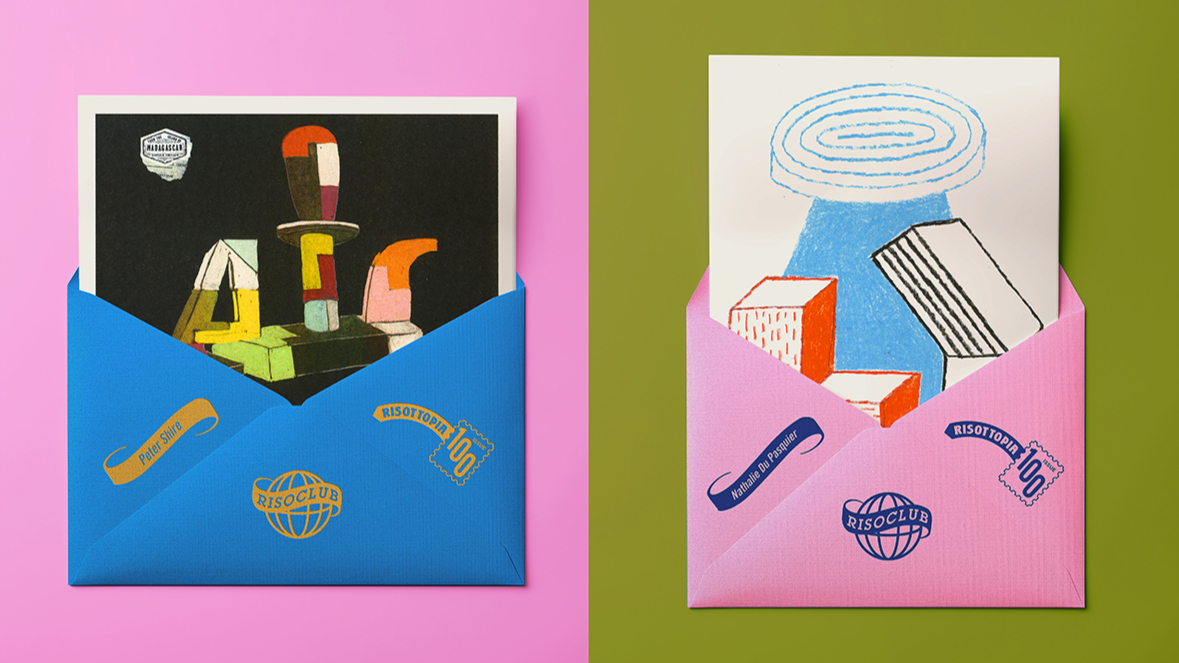 Nathalie Du Pasquier, Peter Shire and Barbara Stauffacher Solomon create exclusive artworks for Riso Club
Nathalie Du Pasquier, Peter Shire and Barbara Stauffacher Solomon create exclusive artworks for Riso ClubGlasgow print studio Risotto celebrates the 100th issue of its monthly Riso Club – a hand-printed, hand-posted subscription that has grown from a small artist exchange into a global community
-
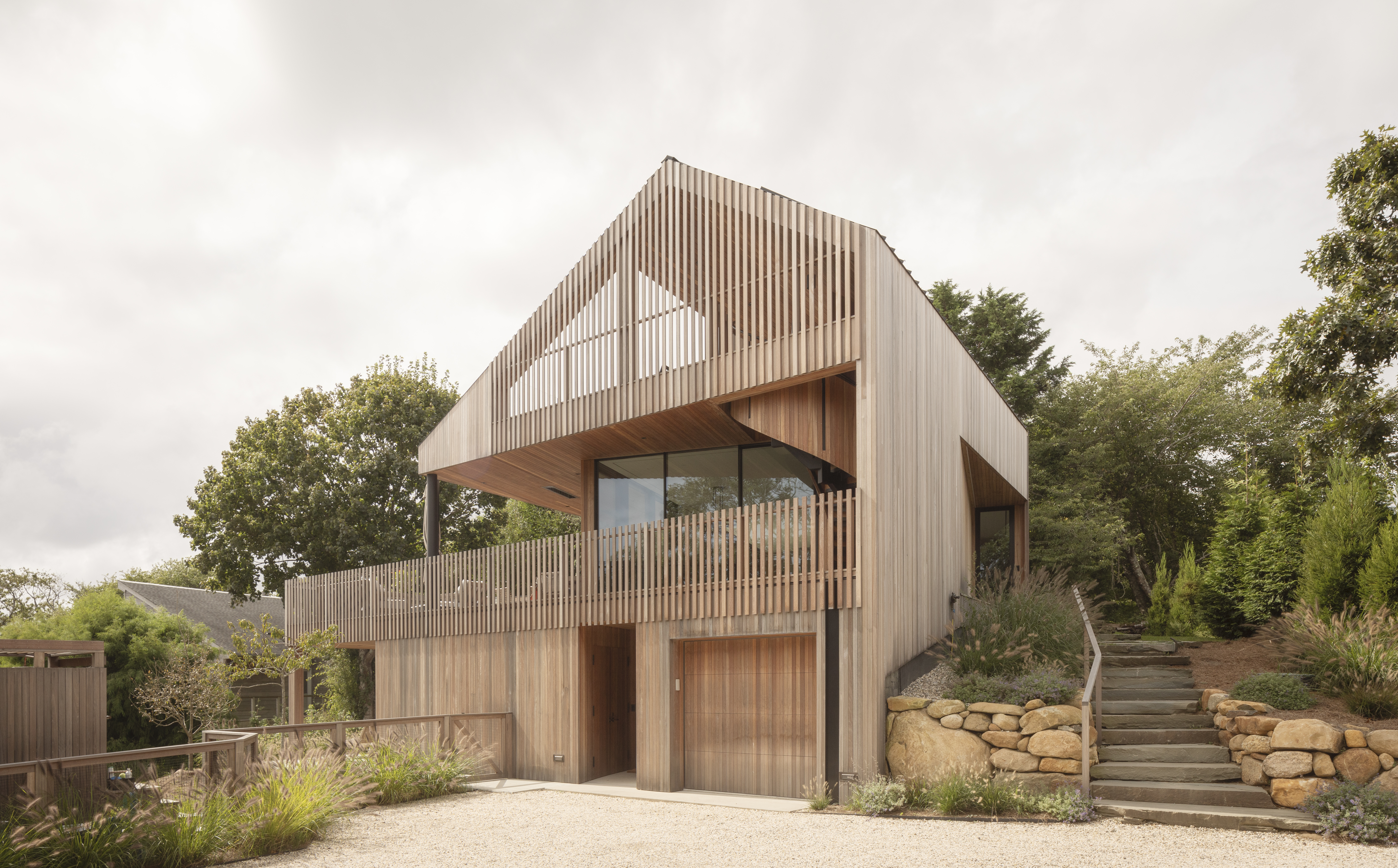 An ocean-facing Montauk house is 'a coming-of-age, a celebration, a lair'
An ocean-facing Montauk house is 'a coming-of-age, a celebration, a lair'A Montauk house on Hither Hills, designed by Hampton architects Oza Sabbeth, is wrapped in timber and connects its residents with the ocean
-
 The story behind Gian Paolo Barbieri’s cinematic fashion photography, which helped define the 1990s
The story behind Gian Paolo Barbieri’s cinematic fashion photography, which helped define the 1990sA new Milan exhibition explores the legacy of Gian Paolo Barbieri, a photographer who would shape a vision of Italian style alongside collaborators Versace, Armani and Valentino
-
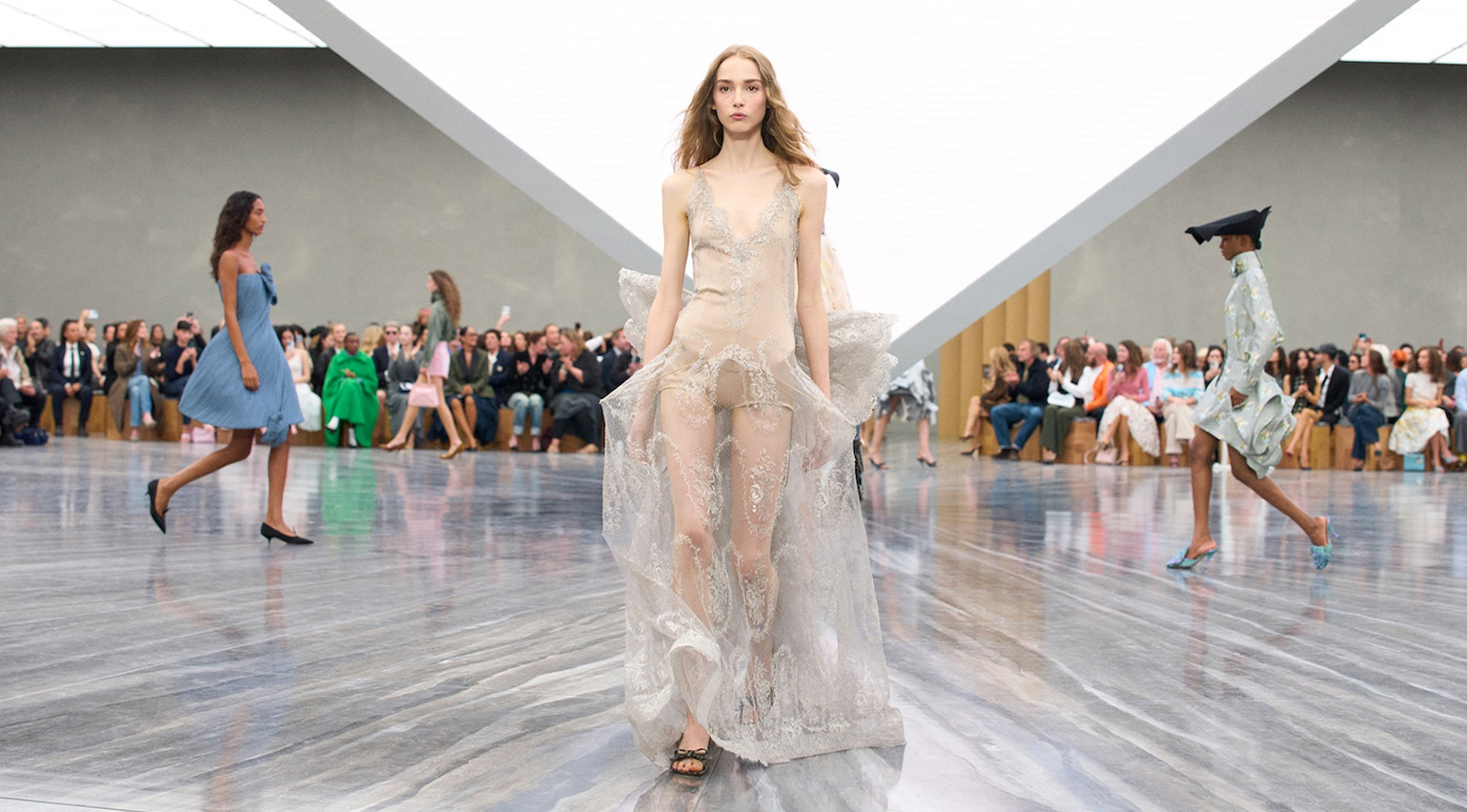 The key takeaways from the S/S 2026 shows: freedom, colour and romance define fashion’s new chapter
The key takeaways from the S/S 2026 shows: freedom, colour and romance define fashion’s new chapterWe unpack the trends and takeaways from the S/S 2026 season, which saw fashion embrace a fresh start with free-spirited collections and a bold exploration of colour and form
-
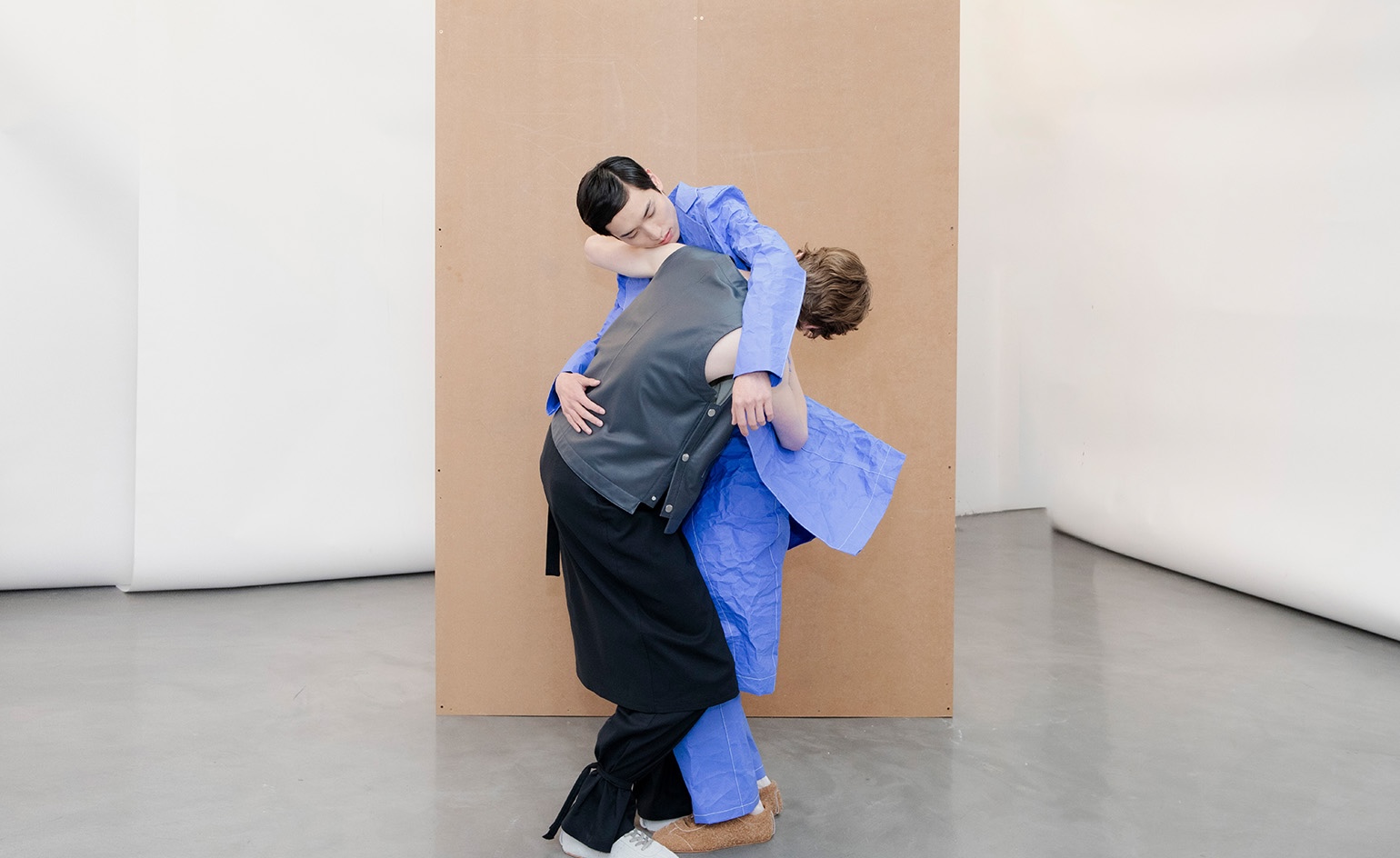 The independent designers you might have missed from fashion month S/S 2026
The independent designers you might have missed from fashion month S/S 2026Amid a tidal wave of big-house debuts, we take you through the independent displays that may have slipped through the cracks – from beautiful imagery to bookshop takeovers, museum displays and moves across the pond
-
 From wearable skincare to scented runways, unpacking the unconventional beauty moments of fashion month S/S 2026
From wearable skincare to scented runways, unpacking the unconventional beauty moments of fashion month S/S 2026The S/S 2026 season featured everything from probiotic-lined athleisure to fragranced runways – and those Maison Margiela mouthguards
-
 In Milan, the fashion world gathers to say goodbye to Giorgio Armani at his final show
In Milan, the fashion world gathers to say goodbye to Giorgio Armani at his final showOriginally planned to mark the 50th anniversary of Giorgio Armani’s eponymous house, Sunday evening’s runway show at Milan’s Pinacoteca di Brera would prove to be the last from the designer, who passed away earlier this month aged 91
-
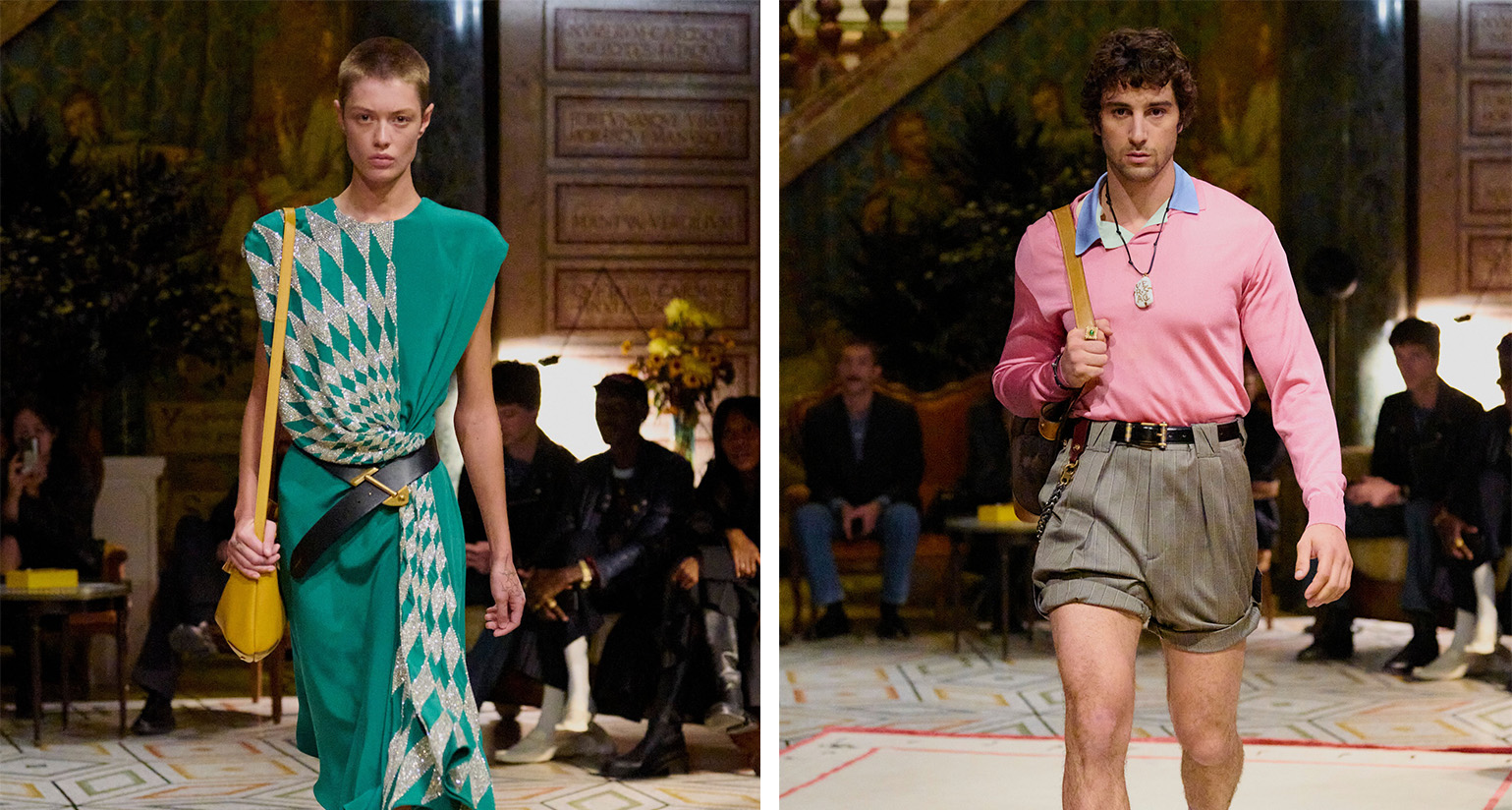 Dario Vitale makes sexually-charged debut for Versace, inspired by the ‘bold attitude’ of Gianni Versace
Dario Vitale makes sexually-charged debut for Versace, inspired by the ‘bold attitude’ of Gianni VersaceSucceeding Donatella Versace, the ex-Miu Miu design director is the first to helm the brand outside of the Versace family. His debut last night in Milan was staged within the opulent rooms of Pinacoteca Ambrosiana
-
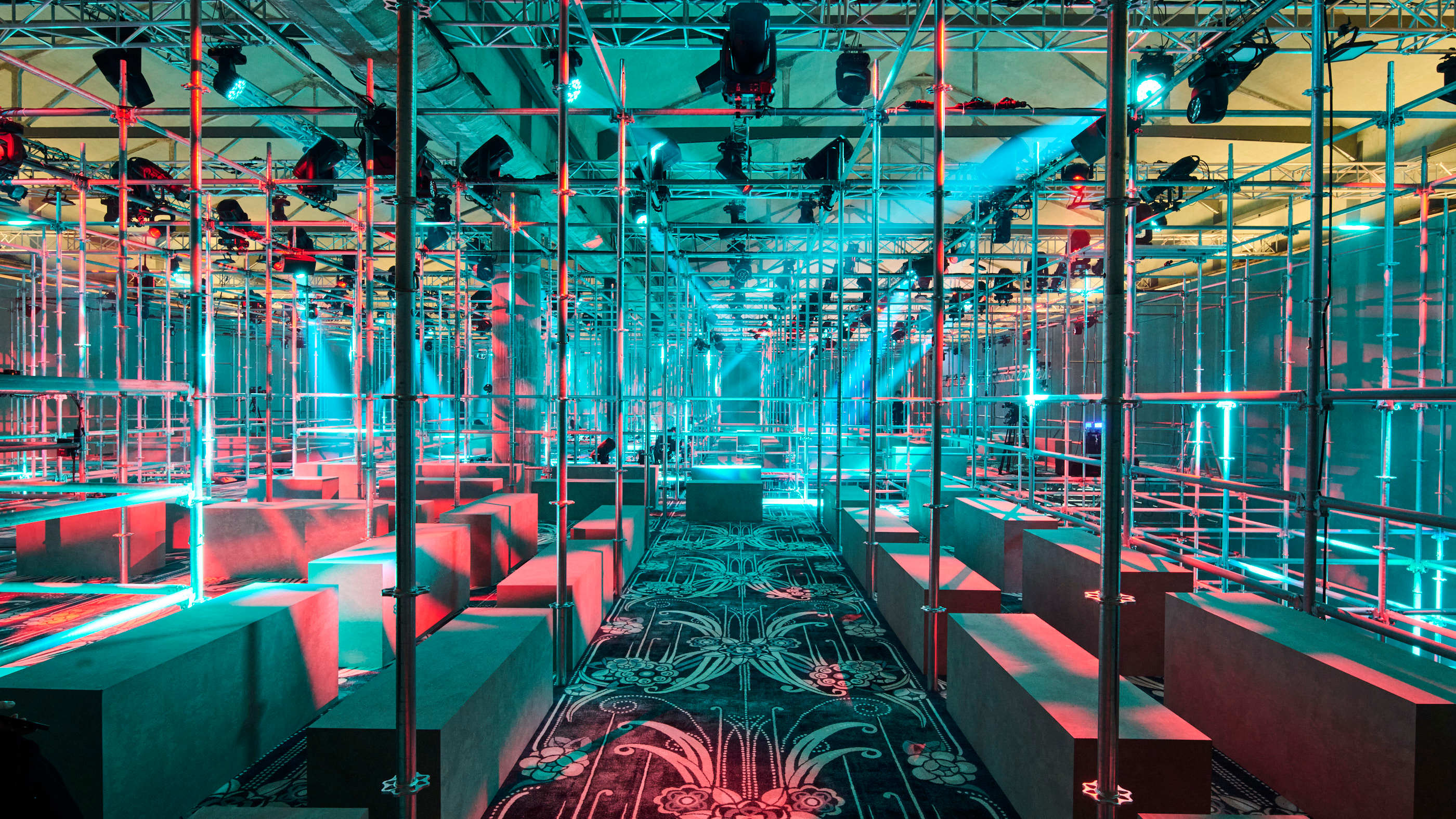 Milan Fashion Week S/S 2026: live updates from the Wallpaper* team
Milan Fashion Week S/S 2026: live updates from the Wallpaper* teamFrom 23-29 September, Milan Fashion Week takes place in Italy’s fashion capital. Follow along for a first look at the shows, presentations and other style happenings, as seen by the Wallpaper* style editors
-
 Gucci reveals its ‘bold, unapologetically sexy’ new era under Demna
Gucci reveals its ‘bold, unapologetically sexy’ new era under DemnaReleased this morning, former Balenciaga creative director Demna gives a glimpse at what to expect from his tenure at Gucci with a debut collection titled ‘La Famiglia’, comprising a cast of archetypes